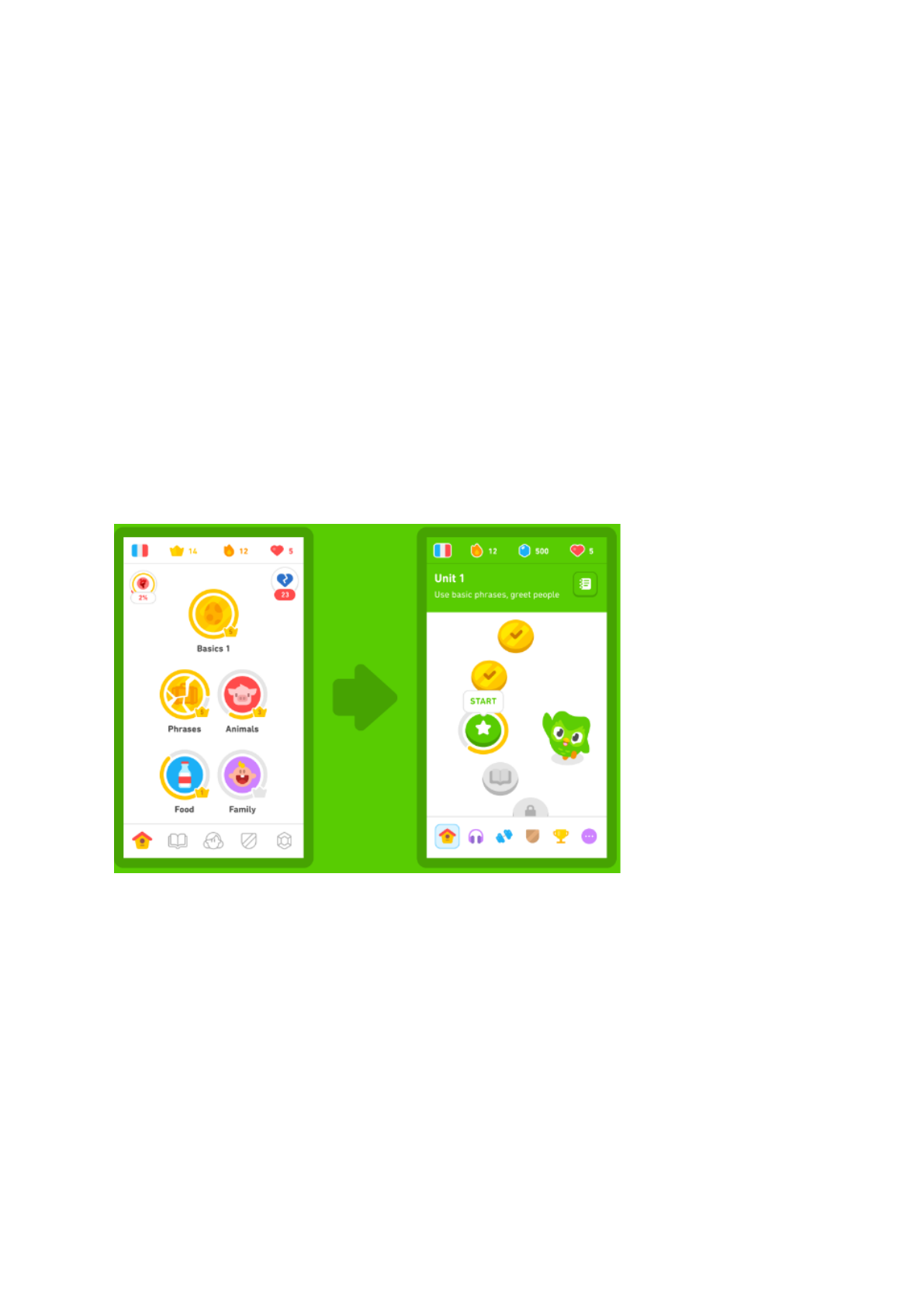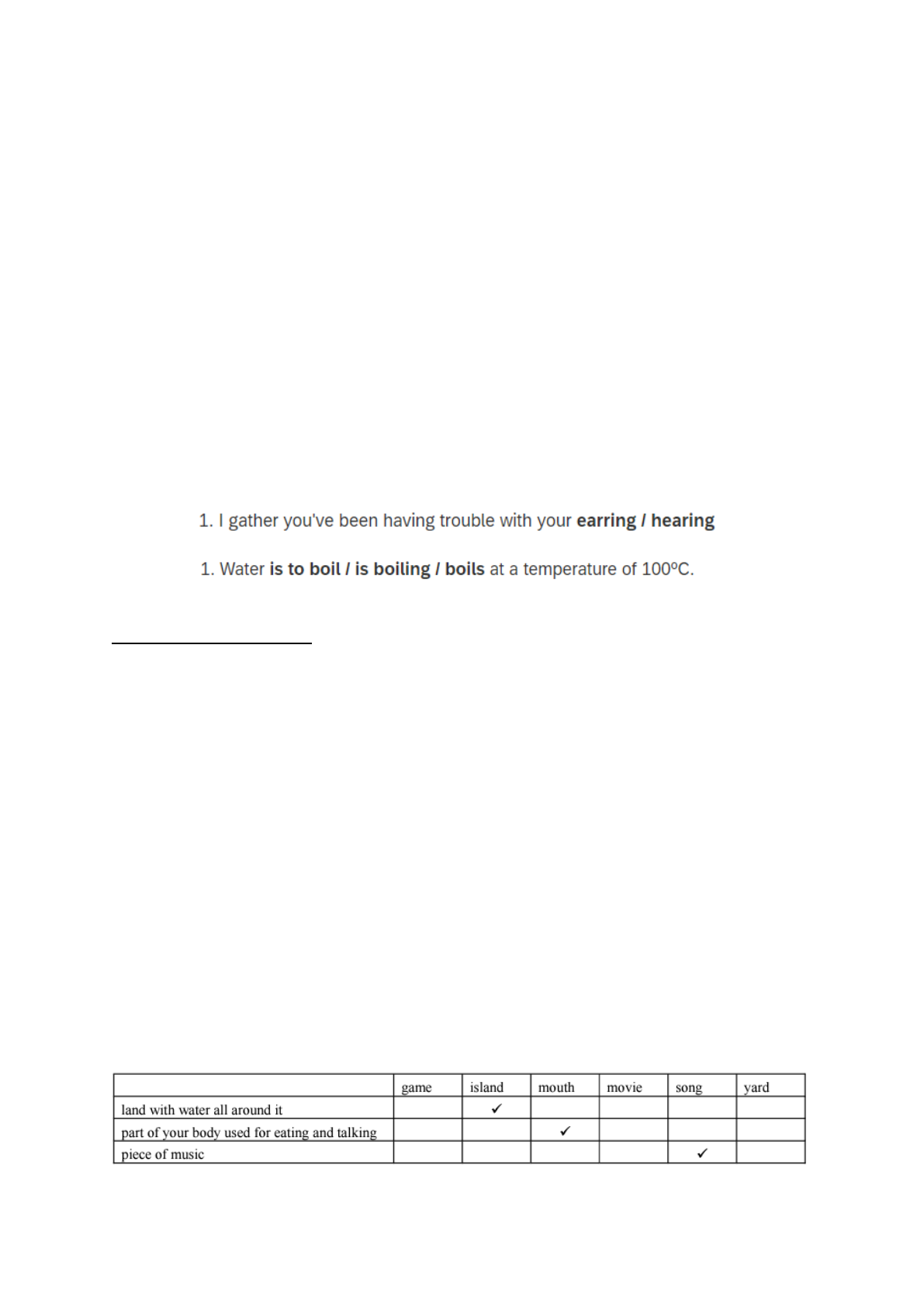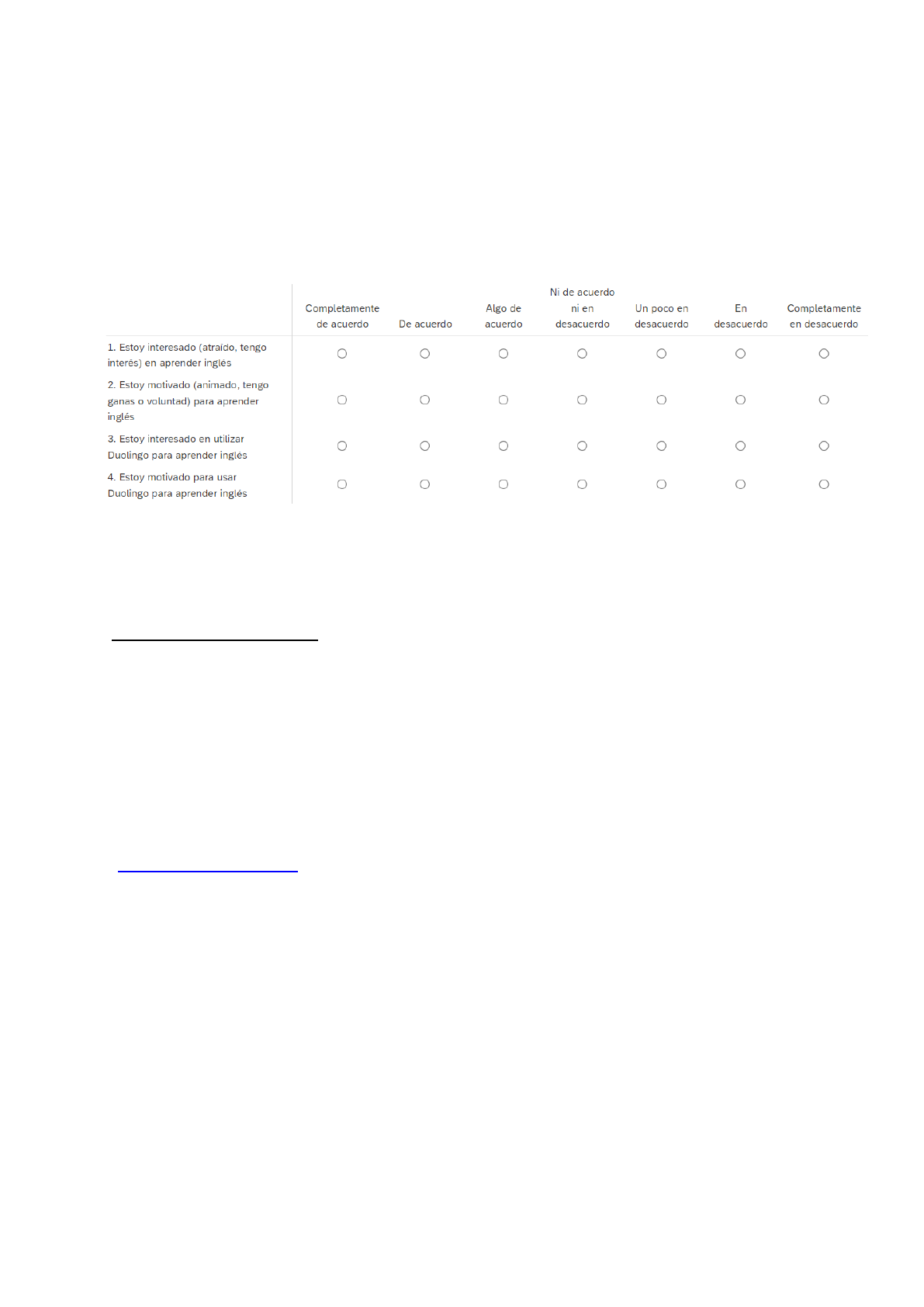
RESEARCH REPORT
November 30, 2023 (51 pages)
The effectiveness of Duolingo vs.
classroom instruction on Spanish
speakers’ L2 English proficiency and
lexical development
Beatriz González-Fernández, University of Sheffield

Research Report
Table of Contents
Abstract..................................................................................................................2
Introduction............................................................................................................ 3
Effectiveness of MALL Apps................................................................................... 4
Motivation and Language Learning......................................................................... 6
Duolingo Course..................................................................................................... 7
The Present Study.................................................................................................. 9
Methodology.........................................................................................................10
Participants................................................................................................................ 10
Instruments................................................................................................................ 12
Procedure...................................................................................................................15
Analyses..................................................................................................................... 16
Results................................................................................................................. 17
L2 proficiency and Lexical Development..................................................................17
L2 Motivation and Engagement................................................................................18
Effect of Mode of Instruction and Learner Factors on L2 Development................20
Discussion............................................................................................................ 24
RQ1: Effectiveness of Duolingo for L2 Development.............................................. 24
RQ2: L2 Motivation and Engagement.......................................................................26
Conclusion............................................................................................................28
Notes....................................................................................................................29
Acknowledgements.............................................................................................. 29
References........................................................................................................... 30
Appendices...........................................................................................................34
Appendix A: Pre-test Motivation Questionnaire.......................................................34
Appendix B: Post-test Motivation and Engagement Questionnaire....................... 40
Appendix C: Additional Analyses..............................................................................47
1

Research Report
Abstract
Language learners around the world are increasingly employing applications (apps)
in order to learn second/foreign languages (L2). However, research on the
effectiveness of these apps for developing general language proficiency, particularly
compared to traditional classroom instruction, is still limited. The manuscript reports
a study that compares L2-English proficiency and lexical development by L1-Spanish
learners in app-based (i.e., Duolingo) versus classroom-based instruction.
Participants completed a background and motivation questionnaire, a test of L2
general proficiency and two tests of receptive and productive vocabulary knowledge
before and after a 16-week instruction period. The results showed a positive effect of
type of instruction in favor of Duolingo on general L2 proficiency and receptive
vocabulary development, and in favor of classroom instruction on listening scores.
For productive vocabulary knowledge, both groups exhibited comparable learning
gains. L2 motivation was high for both groups prior and after the study period, with
Duolingo learners generally reporting higher interest and motivation levels. These
findings demonstrate the effectiveness of Duolingo in developing general L2
proficiency and receptive vocabulary knowledge relative to classroom-based
instruction.
2

Research Report
Introduction
The way in which second/foreign languages (L2s) are learnt has experienced a shift
in recent decades, largely due to the surge in instructional technologies. Computer
and mobile-assisted language learning (CALL and MALL) tools and applications have
become increasingly popular among learners worldwide (Burston, 2015; Jiang,
Rollinson, Plonsky, et al., 2021; Loewen et al., 2019), significantly impacting the field
of (instructed) second language acquisition (SLA) in and outside the classroom. This
move became even more acute in the wake of the COVID-19 pandemic, when
platforms such as Duolingo experienced an increase in new learners of 101% only in
March 2020 (Blanco, 2020). Given their numerous affordances for L2 learning and
instruction (e.g., autonomy and flexibility of use), the adoption of MALL technologies,
and particularly language learning apps, is expected to continue flourishing and
expanding (Loewen, 2020).
Yet, despite the popularity and rapid expansion of language learning apps, research
investigating their effectiveness in promoting L2 proficiency development is lagging
behind adoption (Rachels & Rockinson-Szapkiw, 2018). As a consequence, many in
the SLA field remain skeptical about apps’ potential to be a legitimate alternative to
traditional language classroom instruction (Jiang, Rollinson, Plonsky, et al., 2021;
Loewen et al., 2020). The present study aims to shed light on this issue by exploring
the effectiveness of Duolingo’s English course in facilitating the L2-English
proficiency and lexical development of L1-Spanish learners, and comparing it to the
linguistic development of similar learners enrolled in traditional face-to-face
classroom instruction.
Mobile-assisted Language Learning and Instructed SLA
Alongside traditional L2 classroom teaching, the use of language learning
technologies (CALL and MALL) is now considered one of the core contexts of
instructed SLA (Loewen, 2020). These technologies have been effectively employed
as complements to traditional L2 classroom instruction both during class time and
outside the class. For example, Guaqueta and Castro-Garces (2018) integrated
traditional English lessons with the use of Duolingo during in-class time for a
6-month period, and found not only improvement in learners’ vocabulary knowledge
but also a better attitude to the language learning process. Examining MALL use
outside the class, Wu (2015) found that combining traditional English instruction
with the autonomous use of a vocabulary-building app led to increased study time by
making use of ‘dead time’ (e.g., commuting), which in turn led to significant
improvement in their lexical knowledge compared to receiving only classroom
lessons. Some scholars even argue that MALL apps have the potential to further
transform language learning in the classroom, by moving away from traditional
textbooks towards adaptive learning platforms (Heil et al., 2016).
3

Research Report
However, Loewen (2020) suggests that MALL apps are perhaps more valuable as
independent-use instructional tools, as a means of learning an L2 when access to a
traditional classroom might not be an option. One of the main reasons for the rising
popularity of language learning apps is that they provide learners with a convenient
and affordable solution to L2 learning (Loewen et al., 2020; Rachels &
Rockinson-Szapkiw, 2018). Apps’ other beneficial affordances include: autonomy
(i.e., learners can choose what and how they want to study), flexibility of use in time
and location (i.e., learners can access and practice language learning anytime and
anywhere), individualization and personalization of the learning process (deliver
adaptive materials tailored to learners’ specific proficiency level, personal needs and
study habits) (Kukulska‐Hulme & Viberg, 2018; Loewen, 2020), or course availability
(in some cases, it may be the only alternative to learning minority or artificial
languages). Thus, although apps can be used as one of many tools for learning a
language (including traditional instruction), they are also being employed by learners
as the main or only form of autonomous L2 instruction (Loewen et al., 2020). Yet, it
is well established that the type of instruction learners receive influences their L2
development greatly (Norris & Ortega, 2000). Thus, understanding how effective
independent app-based instruction is for L2 learning relative to traditional classroom
instruction is crucial to advance our knowledge of MALL apps’ role in instructed SLA.
Effectiveness of MALL Apps
As MALL apps become more popular, it is more important for researchers and
practitioners to understand their effectiveness for language learning (Burston, 2015).
While most research on the use of MALL apps has focused on describing their
design instead of investigating their influence in L2 development (Shortt et al., 2023),
there has been in recent years a rise in studies examining the acquisition of L2s
through language learning apps (e.g., Jiang & Pajak, 2022; Jiang, Rollinson, Plonsky,
et al., 2021; Loewen et al., 2019, 2020; Sudina & Plonsky, 2023).
The majority of MALL studies support the use of apps as effective learning tools
(Burston, 2015). Significant learning gains have been reported particularly regarding
reading ability (e.g., Jiang, Rollinson, Plonsky, et al., 2021; Jiang & Pajak, 2022) and
knowledge of vocabulary and grammar at the receptive level (e.g., Loewen et al.,
2020; Rachels & Rockinson-Szapkiw, 2018). However, apps’ effectiveness in
developing oral skills and productive knowledge of lexis and grammar is far less
evident. Most studies do not focus on these aspects of language (Shortt et al.,
2023), and when they do, results show small (or even a lack of) significant gains in
listening skills (e.g., Jiang, Rollinson, Plonsky, et al., 2021), speaking skills (e.g.,
Loewen et al., 2019, 2020; Lord, 2015) or productive vocabulary knowledge.
Regarding the latter, in a meta-analysis of research on the efficacy of apps for
developing L2 vocabulary, Lin and Lin (2019) found that only 7 out of the 29 target
studies examined included some focus on productive vocabulary knowledge; more
4

Research Report
importantly, they showed that learners’ scores in productive vocabulary measures
obtained a smaller effect size than in receptive vocabulary measures. Similarly,
Jiang, Rollinson, Chen, et al., (2021) found that productive vocabulary knowledge
experienced the weakest scores among their L2 measures, suggesting that apps
might be more facilitative in developing receptive vocabulary knowledge. Therefore,
further research is needed to investigate the extent of linguistic development
through the use of language learning apps, particularly in language components
where the available evidence is scarce and less apparent (i.e., productive vocabulary
and oral skills).
Significantly, very few studies have attempted to empirically compare the relative
effectiveness of app-based instruction vs. traditional, face-to-face classroom
instruction (Jiang, Rollinson, Plonsky, et al., 2021). One of the first attempts was
Lord’s (2015) examination of beginning-level Spanish learners in traditional
face-to-face classes vs. using Rosetta Stone to learn English over a 16-week
instruction period. She found no differences between the two groups’ performance
on standardized L2-English tests, despite the discovery that the app-based group
dedicated substantially less time in the program. Yet, she noted that while both
groups had similar outcomes on the linguistic measures, the app-learning students
seemed to struggle more in conversation compared to those in classroom-based
instruction. It should be noted, however, that the study’s sample was very small (12
participants), and thus, the findings are tentative and should be interpreted with
caution. Rachels and Rockinson-Szapkiw (2018) investigated primary school
students learning L2 Spanish through either Duolingo or traditional classroom
instruction, and found that Duolingo was equally effective than traditional lessons in
developing grammatical and vocabulary knowledge when dedicating the same
amount of time studying (40-mins a week during 12 weeks). This led the authors to
conclude that Duolingo may be an alternative option for L2 instruction (p. 84). More
recently, Jiang, Rollinson, Plonsky, et al. (2021) showed that Duolingo learners of two
different L2s (Spanish and French) attained comparable reading and listening skills
to university students studying the L2 for 4 semesters, while spending only half the
amount of time on the program.
As can be seen, the findings from prior studies on the effectiveness of app-based vs.
classroom-based instruction are inconclusive. Some conclude that apps are more
effective than traditional face-to-face language courses based on the fewer hours of
study required to achieve similar outcomes (i.e., Jiang, Rollinson, Plonsky, et al.,
2021; Vesselinov & Grego, 2012). Other research argues in favor of face-to-face
language instruction (despite finding similar language test outcomes) based on the
better ability of classroom-based learners to use the language for communication
(i.e., Lord, 2015). Other studies regard apps and face-to-face classroom courses as
equally effective given similar language learning gains (Rachels &
Rockinson-Szapkiw, 2018). The seemingly inconsistent findings across studies might
5

Research Report
be partially explained by their limitations. Some of the main ones include: a) lack of
pre-test data and control/comparison group (e.g., Jiang, Rollinson, Plonsky, et al.,
2021; Loewen et al., 2019, 2020); b) lack of or minimal control of study time by
participants (e.g., Lord, 2015); c) small variability in learning environment and
samples, mainly covering learners at University level and in the US; and d) small
sample sizes, which present a threat to the validity of their findings – the present
study seeks to improve on these features. These limitations and the mixed findings
highlight the need for further research to offer additional clarity on the comparison of
app-based vs. classroom-based instruction in facilitating L2 proficiency development
(Sudina & Plonsky, 2023).
Motivation and Language Learning
The field of SLA has long established the role of individual differences in L2
development, but how learners’ individual differences affect MALL is still largely
unclear. Learner factors such as motivation or engagement with the course have
been found to be important predictors of language development by research
examining the effectiveness of apps (He & Loewen, 2022; Loewen et al., 2020) as
well as traditional classroom instruction (Saito et al., 2018). Learning a language can
be challenging and stressful, is time-consuming and requires perseverance to keep
studying and practicing (Shortt et al., 2023). Thus, without adequate motivation and
engagement with the language, students are less likely to succeed. As Dörnyei
(2019) explains, the two concepts are interlinked: L2 motivation refers to a student’s
potential for actively learning a language, whereas engagement is the behavioral
manifestation of motivation.
Regarding MALL, app-based learners have been found to struggle significantly with
motivation, engagement and persistence using apps long term, which in turn
influences their learning outcomes (García Botero et al., 2019; Loewen et al., 2019;
Vesselinov & Grego, 2012). For example, García Botero et al. (2019) found that
university students supplementing their language instruction with Duolingo did not
engage with the app and logged in 10 or fewer times in one year. Similarly, Loewen et
al. (2019) showed that only 22% of their participants achieved the goal of studying
the L2 using Duolingo for 34 hours in one semester, and reported that this general
lack of interaction and variation with apps’ features might have affected their
motivation and persistence in using the app.
Conversely, some scholars argue that apps’ typically engaging designs, attractive
interface and gamified features (i.e., game-based elements such as leaderboards,
experience points or reinforcement streaks) might make app learning more
motivating and engaging than traditional instruction for L2 learners, thus promoting
learning (Boudadi & Gutierrez-Colon, 2020; He & Loewen, 2022; Nami, 2020; James &
Mayer, 2019; Shortt et al., 2023). For example, James and Mayer (2019) examined
6

Research Report
college students learning L2-Italian at home using Duolingo versus learning it using
an online slideshow during 7 sessions, and found that, while the groups did not differ
on linguistic achievement, Duolingo learners reported the experience to be more
enjoyable, appealing and less difficult, as well as more willingness to continue
studying the language. In a recent systematic review on the effect of gamification in
language learning, Dehganzadeh and Dehganzadeh (2020) also discovered that most
studies showed an increase in student motivation and enhanced user engagement
and persistence in gamified environments, pointing to the motivational benefits of
MALL apps.
Given this mixed picture on apps’ potential to generate sustained engagement and
motivation, it is important to gain a better understanding of how language motivation
develops and compares across app-based and classroom-based instruction
(Loewen et al., 2019). It is possible that the prevailing gamified features of
app-based self-study and traditional classroom learning settings influence learners’
levels of motivation and engagement with the course differently, and research needs
to further explore this issue (He & Loewen, 2022).
Duolingo Course
Duolingo is one of the most dominant and influential MALL apps in the market, with
more than 300 million users (Shortt et al., 2023). For this reason, it has also attracted
the attention of scholars, being the most investigated MALL platform by SLA
researchers (Dehganzadeh & Dehganzadeh, 2020). The present study is specifically
concerned with the effectiveness of Duolingo’s most popular course: the English
course for Spanish speakers, with over 47 million learners
1
. To better situate the
study, this section provides an overview of the Duolingo English-from-Spanish course
structure at the time of data collection, and compares it generally to the classroom
course. The Duolingo course is aligned with the CEFR (Council of Europe, 2017), and
includes lessons from A1.0 level (targeted to real beginner/basic user) to B1 level
(intermediate/independent user). Participants in the current study were finishing the
A1 level content (section A1.2), which covers general functional and grammatical
topics, and were starting level A2 just before or shortly after the pretest. Based on
Duolingo data, it was estimated that learners would progress through only the A2
content during the 16-week instruction period. Lessons are built around
communicative topics such as family, food, and travel; each topic introduces some
grammar and cultural concepts, although with limited explanations, but the main
focus is teaching new words and sentence structures through various exercise types
(e.g., gap-filling, translations, listen and repeat). Typical exercises include translation,
multiple-choice word recognition questions and spelling. Like other MALL platforms,
Duolingo also possesses gamified elements, such as challenging tasks, reward
incentives, systematic levels, and user rankings based on achievement (Shortt et al.,
2023).
7

Research Report
The current study uses the new Duolingo Version 2, launched in 2022. In the earlier
version, students navigated the platform autonomously and could choose not to
cover all the content on each theme (e.g., animals), because each theme included 5
levels of content but learners were only required to finish the first level to move down
the course. To control for the variation in individual learner behavior and time spent
in each section of the course found in the earlier version (Jiang, Rollinson, Plonsky, et
al., 2021), the new Duolingo Version 2 requires all learners to progress through the
same path, going through the different difficulty levels in each section in a logical
and linear manner (Figure 1). This new version aligns more directly with traditional
classroom instruction, where the teacher typically follows a syllabus and learners are
exposed to the content in the same order and manner. Version 2 provides more
comparability between classroom and app-based learners in the present study.
Figure 1
Duolingo’s New Learning Path (Version 2)
Like the Duolingo course, the classroom course in the present study is also aligned
with the CEFR. Target learners were enrolled in a face-to-face A2-level English
course, and had completed the A1 level in the same mode of instruction. The
classroom syllabus is similar to Duolingo’s in that it follows a communicative
approach, covering familiar topics such as food, travel and family. However, they
differ in that the classroom syllabus has a greater focus on the use of the L2 and
social exchange, and the L1 was discouraged in the classroom. The gamification of
Duolingo’s course is also a main differential point with the classroom instruction.
8

Research Report
The Present Study
Expanding on previous MALL research, the current study follows a
quasi-experimental pretest-posttest design to compare Spanish speakers’ L2-English
proficiency and lexical development after studying Duolingo’s English course (i.e.,
treatment) and after receiving traditional face-to-face English instruction (i.e.,
control). It also evaluates sustained motivation and engagement levels across both
learner groups. To account for the differences in the study-time distribution of
app-based and classroom-based settings (e.g., Lord, 2015), the current study
controls for the length of instruction (fixed to 16 weeks for both groups) as well as
the amount of time spent in the language course (3-4 hours per week) (Jiang,
Rollinson, Plonsky, et al., 2021; Lin & Lin, 2019).
The following research questions are addressed:
RQ1. How effective is Duolingo in developing the general L2 proficiency and
receptive and productive vocabulary knowledge of L1-Spanish learners of
English at a basic proficiency level? How does it compare to the L2-English
development of similar learners receiving face-to-face classroom instruction?
RQ2. How do learner-related factors such as total time spent studying the
course and level of motivation associate with the L2 proficiency and lexical
development of learners in the Duolingo and classroom-based courses?
Following Sudina and Plonsky’s (2023) approach, the current study can be
categorized as a “natural experiment”. This is a type of observational study which
describes “any event not under the control of a researcher that divides a population
into exposed and unexposed groups” (Craig et al, 2017, p.2). In natural experiments,
researchers have less control over the intervention, and use the naturally occurring
variation in exposure to examine the impact of a particular event on the target
outcome. This approach addresses concerns raised on the ecological validity of
findings derived from L2 instruction studies conducted in lab conditions, and their
replicability in less controlled instructional settings (Rogers & Cheung, 2021). In this
sense, natural experiments are considered to have higher ecological validity than
rigidly controlled experiments (Sudina & Plonsky, 2023), and seem particularly
appropriate for studies comparing the effectiveness of app-based and
classroom-based learning, where researcher control is limited (Loewen et al., 2020).
Thus, the present study could be considered a natural experiment insofar as: a) it
follows a pretest-posttest design; b) has a clear intervention that is not rigidly
controlled, as the aim is to examine the effect of input mode in authentic
environments, and c) lacks a random assignment to intervention (i.e., participants
9

Research Report
had already independently enrolled in the target mode of instruction) (Craig et al.,
2017, p.19).
Methodology
Participants
The participants in this study comprised adult Spanish speakers learning L2 English
at a basic proficiency level (A2 CEFR) under two instruction modes: Duolingo or
traditional, face-to-face classroom instruction. The treatment participants were
invited through Duolingo when they were in the latest session of level A1.2 (aligned
with the CEFR) and about to begin level A2.1 (Units 45-46) of the Duolingo English
from Spanish course. In order to qualify to participate in the study, participants had
to be at least 18 years old, reside in English-as-a-foreign-language countries/regions
in Europe (to control for learners’ exposure to the target language outside the
course), self-assess as having low/basic English proficiency, self-report using
Duolingo as the only English language learning tool (i.e., not taking classes or using
other apps during the time of the study), and commit to studying English on Duolingo
for approximately 30 minutes a day for the duration of the study (16 weeks), with a
weekly study target of 3-4 hours. Participants received 100 euros in compensation
for the completion of the study.
The control participants were recruited in the Escuela Oficial de Idiomas (Official
Language School) in Spain. It is a public institution that offers extra-curricular
language courses to the general public (adults over the age of 16). It is regulated and
subsidized by the Spanish Ministry of Education, offering an official language
certificate and making it relatively affordable compared to private language schools.
Same-level courses are typically offered in the morning and evening to cater to as
many people as possible regardless of their professional, educational or personal
commitments. These features result in a diverse student population in terms of age,
profession, or socioeconomic status, who want to improve their English skills for
various reasons (from enhancing their CV/employability to keeping active after
retirement). In this school, the curriculum is aligned to CEFR and approved nationally
by language education authorities. They were adult learners enrolled to begin the
A2-level course, which involves 4 hours of face-to-face instruction per week. To
participate, they had to report only receiving traditional face-to-face classroom
instruction (i.e., not being engaged in app-based English learning at the time of the
study), and commit to regularly attending the English lessons for the duration of the
study. In exchange for their collaboration, a contribution of 700 euros was made to
the institution for purchasing English learning materials (e.g., books).
After initial screening to ensure they met the selection criteria, interested
participants were invited to the pretest (see Procedure). A total of 544 participants
(188 Classroom learners and 356 Duolingo learners) completed the pretesting stage.
10

Research Report
However, 207 participants (72 classroom and 135 Duolingo learners) dropped out
during the study period (i.e., ceased consistently attending the lessons [n=58] or
using the app [n=132]) and/or did not complete the posttest.
The final participant pool of the study were 337 adult L1-Spanish learners of L2
English beginning an A2 level course. They were divided into a treatment group, who
studied English using Duolingo (k = 221) and a control group, who received
traditional classroom English instruction (k = 116). The two groups were matched in
Age (U = 12570.0, z = -.292, p = .770). All participants lived in Spain, except for 4
Duolingo students that lived in Germany, Italy, the Netherlands and Serbia. Table 1
presents a comprehensive picture of participants’ demographic and language-related
features by group.
Table 1
Participant Characteristics
Classroom
(k=116)
Duolingo
(k=221)
Characteristic
k
%
k
%
Age
Mean
45.20
45.5
SD
16.79
11.93
Range
18-79
18-71
Gender
Male
38
32.8
104
47.1
Female
77
66.4
117
52.9
Other
1
.9
Nationality
Spanish
93
80.2
202
91.4
Latino-American (Venezuelan, Peruvian,
Argentinian, Colombian)
23
19.8
19
8.6
Reasons for learning English
For travel
87
75
128
57.9
For education
29
25
27
12.2
For job-related purposes
52
44.8
104
47.1
For fun/leisure
73
62.9
137
62
For memory/brain acuteness
51
44
64
29
For social purposes
39
33.6
45
20.4
As a challenge
44
37.9
69
31.2
Other
Other languages spoken
No
76
65.5
135
61.1
11

Research Report
Yes
40
34.5
86
38.9
Education
Primary
2
1.7
2
.9
Secondary
14
12.1
6
2.7
A-levels
19
16.4
22
10
Vocational
28
24.2
44
19.9
BA
35
30.2
114
51.7
MA
13
11.2
28
12.7
PhD
4
3.4
3
1.4
Prefer not to say
1
.9
2
.9
Studied English before current instruction
No
22
19
45
20.4
Yes
94
81
176
79.6
Years studying
Mean
6.27
6.53
SD
4.97
4.31
Range
0-20
1-20
Spent time abroad in English-speaking country
No
110
94.8
213
96.4
Yes
6
5.2
8
3.6
Months abroad
Mean
7.67
12.88
SD
8.64
14.68
Range
1-24
1-36
Learning difficulty
No
110
94.8
216
97.7
Yes
6
5.2
5
2.3
Instruments
In order to establish generalizations on linguistic development across studies,
standardized rather than researcher-developed measures of language ability are
preferred (Jiang, Rollinson, Plonsky, et al., 2021; Rachels & Rockinson-Szapkiw,
2018). Thus, this study employed standardized tests of English proficiency and
vocabulary knowledge.
Oxford Placement Test (OPT)
The OPT (Allen, 2004) is a standardized measure of overall L2-English ability. It
comprises two sections: 1) Listening, which assesses students' general listening
ability by choosing correct word heard in short sentences; and 2) Grammar, assesses
students’ grammatical and lexical knowledge in context via items that require
reading short sentences and choosing right answer. These multiple-choice tasks are
12

Research Report
similar to the exercises that learners of lower proficiency levels are familiar with
(García Botero et al., 2019). The test takes approximately 60 minutes to complete
(~13 mins for the Listening part, and 50 mins for the Grammar part), and each
section is scored over 100 points (1-0 per item) to produce a total aggregate score
out of 200. The test scores match the CEFR proficiency levels from pre-A1 to C2, and
are fine-grained in that they distinguish between beginner and minimal users at the
pre-A1 CEFR proficiency, making it ideal for the participants in the current study. The
test was validated with multilevel samples of students from more than 40
nationalities over 5 years, and the results calibrated onto the CEFR (Allen, 2004).
Independent investigations also report its reliability as a proficiency test (α=.809,
Wistner et al., 2009). Thus, it is considered a reliable instrument to examine
L2-English proficiency (e.g., Borràs & Llanes, 2020).
Figure 2
OPT Sample Items (listening and grammar respectively)
Vocabulary Levels Tests
Two validated non-timed standardized measures of vocabulary knowledge were
employed to assess learners’ receptive and productive lexical development over the
learning period. The Updated Vocabulary Levels Test (uVLT; Webb et al., 2017)
assesses receptive vocabulary knowledge (meaning recognition) of the most
frequent 5,000 words (1,000-5,000 frequency levels), making it ideal for lower-level
English learners. It takes the form of a word-matching task with extra options, asking
test takers to choose the right meanings (L2 definitions) corresponding to target
items. This format minimizes the chances of guessing as compared to a
multiple-choice task (Kremmel, 2020). The test comprises 30 items representing
each of the five frequency levels. Given participants’ low-proficiency, only sections
1,000-3,000 of the uVLT were administered, comprising 90 items in total (30 per
section) scored dichotomously. The maximum score for these three sections of the
test is therefore 90.
Figure 3
uVLT Sample Items
13

Research Report
The Productive Vocabulary Levels Test (PVLT; Laufer & Nation, 1999) measures
controlled productive knowledge (ability to recall the L2 forms) of the most frequent
2,000, 3,000, 5,000 and 10,000 words, plus academic vocabulary (each in a different
section). Each of the five sections includes 18 items. The task requires learners to
fill-in a gapped English sentence given the first few letters of the target word, and
contextual sentences were carefully created so that target words would not be easily
inferred. Considering the complexity of this test and the lower-proficiency
participants in the present study, only the 2,000 and 3,000 sections of the PVLT were
administered (36 items in total). Elicited responses were scored dichotomously as
correct or incorrect, but minor errors including misspellings (e.g., apartament for
apartment) or grammatical infelicities (e.g., *this skirts) were accepted as correct
responses for these learners as long as the original word identity remained easily
inferable. Thus, the maximum possible score in this test was 36.
Figure 4
PVLT Sample Item
Since research has reported significant improvements in the outcomes of the uVLT
(Borràs & Llanes, 2020) and the PVLT (Nadarajan, 2009) after relatively short
treatments (from 3 weeks to 1 semester), these tests are deemed appropriate for the
current study’s purpose of assessing incremental vocabulary gains over a semester.
In addition, tapping into two different levels of sensitivity (receptive and productive
knowledge) increases the likelihood of detecting small lexical improvements
(Kremmel, 2020) and offers more nuanced insights on learners’ general vocabulary
development.
Background and Motivation Questionnaires
This background portion of the questionnaire was designed following similar
instruments in prior language learning app research (i.e., Loewen et al. 2020 and
Jiang et al., 2021). It included questions related to participants’ linguistic
background, self-assessed English proficiency, previous experience learning English
(in classroom settings as well as with apps), interest in and reasons for learning the
target language. To examine the influence of motivation and engagement in
Duolingo and classroom-instruction learners, the questionnaire also featured
questions targeting the level of engagement with the lessons and their motivation for
learning the language and for the respective course (Duolingo vs. classroom) prior to
starting the course (see Appendix A) and again in the posttest (see Appendix B).
Finally, additional questions about time spent per week using the target language
outside the class or Duolingo, perceptions on learning progress, and level of overall
14

Research Report
enjoyment with the course were included in the post-test questionnaire. Most
questions followed a 7-point Likert scale, making the questionnaire quicker to
answer.
Figure 5
Questionnaire Sample Item
Procedure
The study involved three phases:
Screening and Pretesting
Interested participants completed a screening form to ensure compliance with the
selection criteria (see Participants). After providing their informed consent to
participate in the research, the pretesting session was scheduled with the
participants. Pretesting required participants to take (in the stated order) the
background and motivation questionnaire, proficiency test (OPT) and vocabulary
tests (first PVLT and then uVLT), to control for learners’ prior English knowledge and
motivation level before the learning period. Duolingo learners completed the tests
individually online on Qualtrics, but proctored via a remote monitoring system
(https://hubstaff.com/) which tracks learners’ activity during testing by taking
screenshots, and thus can achieve the aim of monitoring performance in an
unobtrusive way. This remote monitoring ensures the validity of the test scores.
Duolingo participants were informed prior to taking part that the testing sessions
required completion on a computer with good internet access and sound system.
The classroom-based participants completed the tests in person in their classroom
group under the supervision of the researcher. While practical constraints did not
allow for classroom-based participants to be tested online as Duolingo participants,
this provides greater ecological validity to the study design as the groups are
assessed in the same manner in which they receive instruction, aligning with the
requirements of a natural experiment. All instructions were given in participants’ L1
(Spanish). The pretesting stage took approximately 1.5 hours to complete, and the
researchers controlled that participants did not spend too much time in each test by
15

Research Report
limiting completion time according to test guidelines (i.e., approximately 60 minutes
for the OPT) and piloting information (approximately 15 minutes for the uVLT and
PVLT). Participants were informed of these times prior to completion of each task.
Learning Period
Following prior app-based studies (Loewen et al., 2019, 2020; Lord, 2015; Rachels &
Rockinson-Szapkiw, 2018), participants engaged in their respective instruction
program (Duolingo or classroom) over the course of an academic semester (fixed
length of 16 weeks between pretesting and post-testing). To ensure that the amount
of time spent in language learning was comparable between the treatment and
control groups, Duolingo participants were instructed to study approximately 30
minutes per day, with a weekly study target of 3-4 hours. This was measured via
self-reported engagement questions. Duolingo data analytics were also collected,
but not employed in analyses because they were not reliably recorded due to
technical issues. No cut-off minimum number of hours per week was applied, but the
analysis shows that 73.8% of Duolingo learners studied at least 2-3h per week, and
53.7% did more than 3-4h per week. Previous research findings indicate that
app-based learners tend to revisit known material rather than advance through the
course content (Jiang et al., 2021). Thus, Duolingo participants in this study were
instructed to progress along the course as much as they could. Classroom
participants were asked to attend most of the lessons and follow the teachers’ study
plans (~64 hours of instruction in total). Teachers confirmed that the classroom
participants included in the analysis attended regularly (>80%). During the 16-week
study period, the researchers maintained frequent communications with the
Duolingo learners, while allowing for independent study, and with the classroom
teachers. On week 14, a reminder was sent that the posttest was due in week 16.
Post-testing
After the learning stage, participants completed the same tasks and questionnaire
as in the pretest stage –questionnaire, proficiency test, vocabulary tests– in the
same format and order. Additional post-testing questions were added to the
questionnaire asking participants whether they made use of any other courses or
programs than the target ones during the duration of the study, to reflect on their
learning experience and self-assess their English progress. Post-testing was
completed in approximately 1.5 hours. This stage concluded with the conferral of
participant compensation.
Analyses
A series of linear regression analyses were run to examine how mode of instruction
(Duolingo vs. classroom) and learner factors (e.g., total time spent learning English
and motivation) influence learners’ L2 proficiency and lexical development in English
(RQs 1-2). Other potentially influencing factors were controlled for by adding them as
16

Research Report
covariate in the regression analyses (e.g., pretest scores). Separate models were fit
for the pretest and posttest scores for each of the test outcomes (uVLT, PVLT and
OPT). The regression models were run using the lm (Hothorn, 2002) package in R.
Results
L2 proficiency and Lexical Development
Table 2 shows that, overall, the participants’ mean scores across all language tests
were higher in the Duolingo group than the Classroom group, both at pretest and
posttest. However, there was an exception with the OPT Listening task, in which
classroom learners outperformed Duolingo learners prior to and after the study
period. This might be explained by the classroom learners’ higher viewing and
listening exposure to English prior to and after the treatment (see Appendix C, Table
1).
Table 2
Descriptive Statistics for Language Test Scores (N= 337)
Classroom
(k=116)
Duolingo
(k=221)
Test
M(%)
SD
Range
M(%)
SD
Range
OPT Total pretest
Pretest
49.3
8.1
28.5-71
54.6
9.9
13-74.5
Posttest
53
9
14.5-77
58.5
8.9
32.5-77.5
OPT Listening
Pretest
63.8
8.2
42-82
63
12.2
10-85
Posttest
67.2
6.6
47-87
65
10.4
30-84
OPT Grammar
Pretest
34.8
11
8-66
46.3
11.6
12-75
Posttest
39.7
12.3
8-74
52.1
10.8
27-86
uVLT
Pretest
54.7
18.4
8.9-92.2
72.6
15.1
34.4-100
Posttest
63.2
17.5
17.8-93.3
80.2
13.6
40-100
PVLT
Pretest
23.6
11.5
0-61
33.2
13.5
5.6-83.3
Posttest
31.1
10.6
11.1-58.3
39.9
15.5
8.3-88.9
Note. OPT = Oxford Placement Test; uVLT = Updated Vocabulary Levels Test; PVLT = Productive VLT
17

Research Report
To estimate the increase in linguistic knowledge across the two testing times, a
series of Wilcoxon signed-rank tests were conducted for each group independently.
The tests revealed statistically significant gains between the pretest and posttest
scores across all linguistic measures for both the classroom and Duolingo groups (p
<.05, see Table 3 for exact p and d values). This indicates that participants’ general
L2 proficiency and vocabulary knowledge improved significantly during the learning
period, although the effect size (calculated using Cliff’s delta) was small (<.40,
Plonsky & Oswald, 2014).
Table 3
Significance and Effect Size for the Paired Samples (pre-post) Test Contrasts
OPT Total
uVLT
PVLT
Group
p
d
p
d
p
d
Classroom
8.918e-11
0.30
4.015e-14
0.31
6.416e-12
0.18
Duolingo
6.154e-14
0.33
< 2.2e-16
0.46
< 2.2e-16
0.23
In both groups, learning gains were more evident in the two vocabulary measures
than the OPT measure. For the classroom learners, the difference in uVLT scores
between pretest and posttest was 8.5% (63.2-54.7) and for the PVLT 7.5%
(31.1-26.3). In raw figures, this means a learning gain of 7.7 words in the uVLT and
2.7 words in the PVLT standardized measures. Since in the uVLT test 30 items
represent 1,000 words in each frequency band, this translates to an average gain of
256.7 real words at the receptive level of mastery (7.7*33.3). In the PVLT, each item
in the test represents approximately 55.5 words in a frequency band, meaning that
classroom learners gained approximately 150 real words on average (2.7*55.5) at
the productive level of mastery.
The picture is similar for the Duolingo learners, with a difference of 7.6% in the uVLT
(80.2-72.6) and 6.7% in the PVLT (39.9-33.2) from pretest to posttest. In raw figures,
this is an average gain of 7 words in the uVLT task and 2 in the PVLT task, translating
into 233.3 real words gained at receptive knowledge and 111.1 at productive level.
L2 Motivation and Engagement
As shown in Table 4, participants’ level of motivation and interest in the language
and the target program prior and after the instruction period was very high in both
groups. However, a decline in motivation and interest was found for both groups
after the study period.
18

Research Report
Table 4
Interest and Motivation prior and after Instruction
Classroom
(k=116)
Duolingo
(k=221)
Characteristic
M
SD
Range
M
SD
Range
Interested in English
pretest
6.69
.55
4-7
6.81
.51
2-7
posttest
6.65
.59
4-7
6.75
.49
5-7
Motivated in English
pretest
6.61
.68
4-7
6.62
.66
2-7
posttest
6.53
.71
4-7
6.47
.84
2-7
Interested in the lessons
pretest
6.72
.49
5-7
6.71
.62
1-7
posttest
6.54
.73
4-7
6.60
.62
4-7
Motivated in the lessons
pretest
6.69
.57
4-7
6.70
.60
1-7
posttest
6.43
.91
2-7
6.57
.75
2-7
Note. Rated on a 1-7 Likert-Scale (1= Strongly disagree, 7 = Strongly agree).
To estimate changes in motivation from pretest to posttest, a two-way ANOVA with
repeated measures was run, checking the effects of sustained motivation at posttest
(within-subject), group (between-subject), and their interaction on the motivation
pretest scores. The results showed a significant main effect of posttest motivation in
English within-subjects (p < 2e-16). However, no significant main effect of group was
found (p = 0.486). The interaction effect between posttest motivation in English and
group was also not significant (p = 0.149). The effect size, eta squared (η²), was
0.26, indicating a moderate effect (Plonsky & Oswald, 2014). Overall, this suggests
that, on average, participants’ motivation significantly changed from pretest to
posttest, showing decreased levels of motivation after the study period, but this
occurred at the individual level (within each participant) rather than at the group
level.
A series of t-tests were conducted to compare the interest and motivation in the
language between the two groups prior and after the intervention. A Welch Two
Sample t-test (used to account for the different sample size between the two groups)
showed no significant differences between the Classroom and Duolingo participants
in their interest and motivation in learning the language prior to the study period (p
=0.060 and 0.965, respectively). However, when level of motivation in the posttest
(i.e., sustained motivation) was compared, a Wilcoxon rank sum test indicated a
significant difference between the groups (p =2.458e-08). The median score for the
Classroom group was 5 (Q1 = 4, Q3 = 6), and for the Duolingo group it was 6 (Q1 = 5,
Q3 = 7), indicating that the Duolingo learners reported being more motivated on
19

Research Report
average in the posttest than the Classroom learners, with a medium-size effect (r =
0.49). Thus, these analyses show that both groups had higher motivation levels at
the pretest, but the Duolingo learners in general seemed to report slightly higher
levels of motivation at posttest than the classroom learners.
Finally, in order to explore the influence of engagement with the course, students
were asked to report the average time they spent studying English per week during
the study period. Table 5 shows that classroom learners reported spending an
average of 4-5 hours per week studying English (including lesson time), while
Duolingo learners spent on average about 2.5 hours studying English weekly. A
Welch Two-Sample t-test showed a statistically significant difference between the
groups (p <.001), indicating that Classroom learners spent significantly more time
studying English than Duolingo learners. This suggests that, on average, the
Duolingo group did not reach the weekly study goal of 3-4 hours. However, a
frequency analysis revealed that 53.7% of Duolingo learners reported studying the
English course 3 or more hours per week, meaning that most of them met the study
target.
Table 5
Average Time Studying English per Week in the Target Mode
Classroom
(k=116)
Duolingo
(k=221)
Characteristic
M
SD
Range
M
SD
Range
Average time studying English per week
a
6.17
1.6
3-8
4.37
1.4
1-6
Note:
a
Values represent: 1= 1-30 mins, 2= 31-60 mins, 3= 1-2h, 4= 2-3h, 5= 3-4h, 6= 4-5h, 7= 5-6 h,
8=6+ h
Effect of Mode of Instruction and Learner Factors on L2 Development
To answer RQs 1 and 2, learners’ language gains over time were examined in relation
to their target mode of instruction and self-reported motivation and engagement
level in the course. General linear models were conducted with Mode of Instruction
(i.e., Duolingo vs. Classroom) as the main independent variable and the scores on
the language tests (OPT, uVLT and PVLT) as the dependent variables. Separate
models were run for each dependent variable. Motivation and time spent studying
English (i.e., engagement) were also modeled as predictors to isolate and better
understand the effect of mode of instruction on any gains.
First, the two groups were compared statistically to check for any differences in their
L2 knowledge prior to the treatment. Mann-Whitney U pairwise comparisons
between the pretest scores of the two groups with post-hoc analyses (Bonferroni
adjustment p =.025) showed significant differences across all linguistic measures,
20

Research Report
with an advantage of the Duolingo group (p <.001). Although both groups were
starting an A2-level course, it is possible that the Duolingo students’ level was higher
than estimated (OPT Total raw mean score was 109.3, which corresponds to an
A2-level in the CEFR [105-119 OPT scores = A2 CEFR]). Thus, the Duolingo learners
overall might have been in the beginning stages of the A2-level when completing the
pretest, as compared to the classroom learners who had just achieved the A1 level
(OPT Total raw mean scores was 98.6 [90-104 = A1]). This aligns with Jiang and
Pajak’s (2022) finding that their Duolingo learners at the end of the A2 Duolingo
English course for Spanish speakers aligned with an Intermediate level on the ACTFL
scale.
To control for the difference in prior knowledge between groups, the pretest scores
for each dependent variable was included as a covariate in their respective posttest
model. Preliminary ANCOVA tests were first conducted using only the main predictor
Mode of Instruction and the relevant pretest scores as covariates to control for the
differences observed at pretest (see Appendix C). Then, linear regression analyses
were computed to help us better understand how each variable contributes to the
variation in the posttest scores and provide more detailed insights into our data. The
results are presented below by dependent variable.
OPT
A linear regression model was conducted to examine the effect of the target
predictors (i.e., Mode of Instruction, Engagement [time spent studying per week] and
Motivation) on the OPT Total posttest scores. The pretest score was included as a
covariate to control for initial differences. The results showed a significant effect of
Mode of Instruction (p <.001), with the coefficient (3.25) indicating that participants
in the Duolingo group had a higher estimated OPT posttest score compared to the
Classroom group. This suggests that, after statistically controlling for initial
differences in the OPT Total scores at the start of the course, the learners in the
Duolingo group outperformed the Classroom group in their general L2 proficiency at
the end of the study period. The baseline scores (OPT pretest) and self-reported
interest in English learning (Interested English) were also found to be statistically
significant predictors of the OPT posttest scores, but time studying per week did not
appear to be significant. This suggests an influence of interest but not engagement
on the OPT scores (see Table 6).
Table 6
OPT Total Posttest Model
Predictor
Estimate
SE
t value
Pr (>|z|)
Intercept
27.55001
10.68310
2.579
0.01*
OPT Total pretest
0.68732
0.03704
18.556
<.001***
Group
3.24871
1.60978
2.018
0.04*
21

Research Report
Time studying per week
-0.03905
0.44840
-0.087
0.93
Interested in English
3.91826
1.84460
2.124
0.03*
Motivated in English
-2.78241
1.58261
-1.758
0.08
Interested in the lessons
1.06851
2.60555
0.410
0.68
Motivated in the lessons
-1.09533
2.51819
-0.435
0.66
Model Adjusted R-squared
0.55
Linear regression models were also fit for each section of the OPT to explore the
relationship between the Grammar and Listening posttest scores and the target
predictors. The pretests scores were included as covariates to control for initial
differences. The results (see Table 7) showed that Mode of Instruction (p <.001) and
Motivation in English (p <.01) were significant predictors of OPT Grammar posttest
scores when controlling for the pretest scores. This suggests that Duolingo learners
displayed a significantly greater improvement in grammar knowledge than the
classroom students after the 16-week study period.
Table 7
OPT Grammar Posttest Model
Predictor
Estimate
SE
t value
Pr (>|z|)
Intercept
11.39841
6.05196
1.883
0.06.
OPT Grammar pretest
0.73809
0.03587
20.579
<.001***
Group
3.64244
1.01250
3.597
<.001***
Time studying per week
-0.01732
0.26501
-0.065
0.95
Interested in English
2.40508
1.08986
2.207
0.03*
Motivated in English
-2.95534
0.94412
-3.130
.002**
Interested in the lessons
1.94174
1.57181
1.235
0.22
Motivated in the lessons
-1.57028
1.50515
-1.043
0.30
Model Adjusted R-squared
0.66
For the Listening posttest scores (Table 8), the results showed that Listening pretest
scores were a significant predictor of improvement in listening, indicating that
participants who scored higher at pretest tended to perform better in the posttest.
The model also showed a significant difference in listening scores at posttest (p =
0.05) between the Classroom group and the Duolingo group. Importantly, however,
as opposed to the previous models, the advantage in this case was for the
Classroom group. This suggests that classroom learners exhibited a greater
improvement in their Listening skills when compared to the Duolingo learners.
22

Research Report
Table 8
OPT Listening Posttest Model
Predictor
Estimate
SE
t value
Pr (>|z|)
Intercept
30.87740
6.83350
4.519
<.001***
OPT Listening pretest
0.45019
0.03913
11.505
<.001***
Group
-1.85377
0.98190
-1.888
0.05*
Time studying per week
0.18606
0.28208
0.660
0.51
Interested in English
1.69864
1.15959
1.465
0.14
Motivated in English
-0.54888
0.99536
-0.551
0.58
Interested in the lessons
0.34264
1.63924
0.209
0.83
Motivated in the lessons
-0.23880
1.58579
-0.151
0.88
Model Adjusted R-squared
0.30
uVLT
The linear regression analysis for the uVLT shows that Mode of Instruction was a
significant predictor of learning in the posttest when controlling for pretest scores,
with an advantage for the Duolingo group (p =.001). Moreover, a significant effect of
the uVLT pretest scores was found, indicating that higher receptive vocabulary
pretest scores are associated with higher posttest scores, regardless of the group
(Table 9).
Table 9
uVLT Posttest Model
Predictor
Estimate
SE
t value
Pr (>|z|)
Intercept
14.36422
7.38224
1.946
0.05*
uVLT pretest
0.73731
0.03105
23.746
<.001***
Group
4.16426
1.27380
3.269
0.001**
Time studying per week
0.23758
0.32902
0.722
0.47
Interested in English
-0.32990
1.35565
-0.243
0.81
Motivated in English
0.48811
1.16303
0.420
0.68
Interested in the lessons
2.20469
1.90978
1.154
0.25
Motivated in the lessons
-1.92205
1.85138
-1.038
0.30
Model Adjusted R-squared
0.71
PVLT
Linear regression analyses fitted to predict PVLT posttest scores while controlling for
the target predictor variables showed that only Mode of Instruction (p <.001) and
prior Motivation in English (p <.001) had significant effects on the PVLT posttest
scores. However, the model showed a very small adjusted R-squared (0.1016),
indicating that it could explain only a relatively small proportion of the variance.
23

Research Report
Given the relationship between receptive and productive vocabulary knowledge,
where development of receptive knowledge precedes that of productive knowledge
(González-Fernández & Schmitt, 2020), the uVLT pretest scores were also included
as a covariate in this model. The new model fitted the data better, and found that
only Motivation in English and the PVLT (p<.001) and uVLT (p<.05) pretest scores
were significant predictors of PVLT posttest scores (Table 10). This suggests that
when accounting for prior vocabulary knowledge, the effect of mode of instruction
disappeared in the learning of productive vocabulary.
Table 10
PVLT Posttest Model
Predictor
Estimate
SE
t value
Pr (>|z|)
Intercept
10.63522
8.05631
1.320
0.19
PVLT pretest
0.63633
0.06535
9.737
<.001***
Group
0.98457
1.39053
0.708
0.48
Time studying per week
0.22917
0.36019
0.636
0.53
uVLT pretest
0.11787
0.05085
2.318
0.02*
Interested in English
-0.20992
1.48677
-0.141
0.89
Motivated in English
-2.60732
1.28310
-2.032
0.04*
Interested in the lessons
2.13170
2.08418
1.023
0.31
Motivated in the lessons
0.15412
2.02151
0.076
0.94
Model Adjusted R-squared
0.53
Discussion
The present study set out to compare the motivation level and gains in L2 proficiency
and vocabulary knowledge of classroom and Duolingo L1-Spanish beginner learners
of English. It builds on prior research by controlling for length of program and study
time, while allowing for learner autonomy to maximize ecological validity. The
findings and implications are discussed below.
RQ1: Effectiveness of Duolingo for L2 Development
There are two main findings connected to this RQ. First, the scores across the
standardized linguistic measures were significantly higher at posttest compared to
pretest for both groups. This shows that both modes of instruction (i.e.,
classroom-based vs. app-based) led to significant improvement in L2 proficiency and
lexical knowledge after 16 weeks of studying. This finding corroborates the notion
that low-proficiency L2 learners benefit from deliberate instruction in the L2,
regardless of type (Lord, 2015; Rachels & Rockinson-Szapkiw, 2018). Although the
gains seem modest, the fact that they are evident in standardized measures is
24

Research Report
significant (Lord, 2015; Rachels & Rockinson-Szapkiw, 2018). Among all the linguistic
tasks, students showed a greater average improvement on vocabulary knowledge,
both at the receptive and productive levels of mastery. This corroborates prior claims
that MALL apps are effective for vocabulary development (Lin & Lin, 2019). As
shown by much previous research (e.g., Jiang, Rollinson, Plonsky, et al., 2021; Lin &
Lin; 2019; González-Fernández & Schmitt, 2020), improvement was greater in
receptive vocabulary than productive vocabulary. Although expected, the current
study shows that this applies under app-based instruction as well as
classroom-based instruction. In a previous study, Jiang, Rollinson, Plonsky, et al.,
(2021) found that their productive vocabulary knowledge task reported the weakest
performance among all their measures, suggesting that apps such as Duolingo
might be more facilitative in developing receptive than productive vocabulary
knowledge. The current findings demonstrate that Duolingo’s course focus on lexis
(Shortt et al., 2023) is effective at the receptive and productive level.
Secondly, after accounting for pretest differences in L2 knowledge between the
groups, the results of regressions analyses showed that there was a significant main
effect of Mode of Instruction on posttest scores across all linguistic measures,
except the PVLT. The models showed a general advantage of Duolingo learners over
classroom learners on the scores in the OPT Total, OPT grammar, and uVLT after the
16-week learning period. However, for the OPT Listening task the classroom learners
were found to significantly outperform Duolingo students after the study period. This
finding corroborates previous claims that type of instruction significantly influences
students’ L2 development (Norris & Ortega, 2000). Importantly, it points to the
positive effect of using Duolingo compared to traditional classroom instruction for
the acquisition of overall L2 proficiency, receptive grammar knowledge and receptive
vocabulary knowledge. This finding is in line with much prior research which shows a
beneficial impact of the use of apps, and specifically Duolingo, on various language
competencies (see Shortt et al.’ 2023 systematic review). The results also
demonstrate that when the study time between app-based and classroom-based
learners is more comparable (unlike in studies such as Lord 2015), app-based
instruction can outperform classroom instruction on certain linguistic aspects.
The findings also indicate that classroom instruction was more beneficial for the
development of listening skills than MALL instruction. This aligns with prior
statements that classroom instruction may provide more opportunities to interact via
spoken language and thus for developing oral skills. For example, Lord (2015) noted
that while both groups had similar outcomes on the linguistic measures, the
app-learning students struggled more in conversation compared to those in
classroom-based instruction. Participants in Loewen et al. (2020) also perceived
app-based learning to be effective for grammar and vocabulary development, but
less so for speaking skills (even by the most successful participants). One of the
advantages of apps is flexibility of use, and research has shown that apps are
25

Research Report
typically used during ‘dead time’ such as commuting (Wu, 2015). It is possible that
when using apps in this manner, students do not turn on the audio in the listening
activities, but they can still complete the task and progress through the path because
listening tasks tend to be supported by reading. Thus, their listening opportunities
would be reduced. To improve on this aspect, apps could try to better control the
listening exposure that students received, perhaps by including self-evaluation
exercises to raise awareness of how many audios they have listened to, or by
implementing progression locks, whereby students have to complete a minimum
number of listening-only tasks before they can progress on to the next lesson
(balanced with flexibility to avoid frustration and disengagement). It is worth noting
that the Classroom learners reported higher weekly exposure to oral English than the
Duolingo learners through watching videos/TV programs and listening to radio,
podcasts, and music, which might explain classroom learners’ greater listening
ability. Previous research has shown that regular out-of-class exposure to
listening-oriented activities can be effective at developing listening skills (e.g.,
Muñoz & Cadierno, 2021).
Interestingly, the findings of the current study show that both modes of instruction
were equally effective regarding the development of productive vocabulary
knowledge. While receptive vocabulary knowledge is considered important for
receptive L2 skills, such as reading and listening, productive vocabulary knowledge is
needed for the productive skills of writing and speaking. Indeed, the PVLT is strongly
associated with L2 production proficiency (Suzuki & Kormos, 2023). Based on this, it
seems that both modes of instruction have similar potential to promote the
development of productive skills at a basic proficiency level. However, further
research is needed to demonstrate if this is the case by actually assessing learners
on their productive skills. In addition, it is worth mentioning that Spanish and English
share a significant number of cognate words (i.e., words that derive from the same
original language). Between 34–37% of English words are cognates with Spanish
(Lubliner & Hiebert, 2011). Thus, it is possible that this cognateness might explain
the relatively good vocabulary gains in the current sample, particularly at the
productive level. Future investigations could compare app-based and
classroom-based learning on the lexical development of English learners from
non-cognate languages.
RQ2: L2 Motivation and Engagement
Regarding the effect of motivation and engagement on L2 learners’ linguistic
development under both modes of instruction, the results paint a mixed picture. The
level of engagement (as measured by average time studying per week) was found to
be significantly different between the two groups, with classroom learners reporting
spending on average more time studying English compared to Duolingo learners. Yet,
54% of the Duolingo learners met the study target of 3-4 hours per week, and thus
26

Research Report
engaged with the course a similar amount of time than classroom learners. This
differs from prior app-based research which showed a general lack of engagement
and persistence with the app course (e.g., only 22% of learners achieved study target
in Loewen et al. 2019). It also might explain why average time studying per week did
not significantly predict development across any of the linguistic measures in this
study, despite study time and persistence being known to strongly influence learners’
linguistic development (García Botero et al., 2019; Loewen et al., 2019, 2020; Norris &
Ortega, 2000).
Interestingly, despite spending more time studying English, classroom learners’ L2
improvement was smaller than for the Duolingo learners. One possible explanation is
that although classroom-based learners spend more hours per week attending
English lessons, it does not necessarily mean that they are engaged with the
activities. On the contrary, in order to complete the lessons and progress on the
course, app-based learners need to actively engage with the tasks, even if for a short
period of time. Another factor might be the gamification elements in app-based
learning, which provide learners with a sense of achievement and progression after
every unit. In a classroom setting, however, feedback and sense of progression may
be delayed or restricted to end-of-semester testing. Thus, even though Duolingo
learners spent somewhat less time studying on average, the lesson time seems to
have been more effective.
Concerning motivation, the study shows that learners in both groups had a high level
of motivation in the lessons and the language prior to the learning period, but that
this motivation decreased significantly after the study period. Due to its dynamic
nature, it is common for motivation levels to change over time (Dörnyei, 2019), and
the present study shows that this occurs in both app-based and classroom-based
instruction. Interestingly, the findings also indicate that Duolingo learners in general
seemed to have slightly higher levels of motivation at posttest than the classroom
learners. This runs counter to prior research that shows that app-based learners
struggle significantly with motivation, engagement and persistence using apps long
term (e.g., García Botero et al., 2019; Loewen et al., 2019). This difference in
motivation
2
between both groups could be influenced by the learning experience. It is
possible that the gamification of Duolingo has led to learners finding the experience
more appealing and enjoyable, leading to increased levels of motivation after the
study period (e.g., James & Mayer, 2019). As suggested by He and Loewe (2022),
another possible reason why Duolingo learners in this study experienced greater
levels of motivation and engagement than in previous studies might be the explicit
weekly goal-setting (i.e., specifying a target study time per week and recording this
time). Overall, the current findings point to the motivational benefits of Duolingo for
L2 learning.
27

Research Report
Finally, regarding the influence of motivation on linguistic achievement, self-reported
motivation in this study only seemed to have a significant effect on the OPT Total,
OPT Grammar and PVLT scores at posttest. This contradicts previous claims that
consider motivation as one of the main predictors of linguistic performance
(Loewen, 2020). The reason for this finding might be inconsistencies between
students’ questionnaire responses and their behavior. For example, García Botero et
al. (2019) found that students reported high motivation and positive attitude toward
using apps, but when interviewed they demonstrated mixed perceptions and a lack
of interest in using the app long term. Future research could further examine this
relationship by collecting interview data on participants’ motivation. Admittedly, the
motivation survey employed in the current study conceptualizes the construct
somewhat broadly. Future research should adopt existing validated scales of
motivation and engagement to assess these constructs, which would allow for a
more precise interpretation of the effect of motivation/engagement on learning
gains.
Conclusion
Although several studies have researched L2 learning through Duolingo (e.g., Loewen
et al., 2019; or Sudina & Plonksy, 2023), this is the first study to examine the
effectiveness of Duolingo on overall L2 proficiency with a control group, and to
assess learners’ vocabulary development at receptive and productive levels (Shortt
et al., 2023). The results show that for older L1-Spanish adult learners at a basic
proficiency level, Duolingo instruction seems to be more effective for L2-English
development than classroom instruction. Specifically, Duolingo’s English course for
Spanish speakers was most effective in developing L2 general proficiency and
receptive vocabulary knowledge. However, the study shows that some more
refinement might be needed to enhance the course’s efficacy in facilitating listening
skills and productive vocabulary knowledge. In summary, the findings from the
present study point to Duolingo as a promising alternative to more traditional L2
teaching methods for the development of L2 proficiency and lexis in learners of
basic proficiency level. Given that Duolingo is one of the most popular language
learning apps, the findings of the present study also offer more generalizable
insights on the effectiveness of app-based vs. classroom-based instruction for the
acquisition of L2s.
28

Research Report
Notes
1. Information on the number of learners in the English course for Spanish
speakers was found at https://www.duolingo.com/courses.
2. The motivation results only represent participants who persisted and
completed the study, who are likely to have more sustained motivation than
those participants who dropped out.
Acknowledgements
This project was funded by a Duolingo Efficacy Research grant but was designed and
conducted independently by the author. I would like to thank Duolingo and its
Efficacy Research Lab for their interest in the proposed study, and for their support
and assistance throughout the entire process. In particular, I am grateful to Xiangying
Jiang for her support and patience in advertising the project to Duolingo learners on
multiple occasions so that the sample targets could be met. I am also incredibly
grateful to all the language learners who saw the study’s value for their linguistic
development and generously contributed their time, energy, and knowledge to this
study. In addition, my sincere thanks go to Luis Miguel Morala and the directors and
teachers of the Escuela Oficial de Idiomas in Madrid and Gijón for seeing the value in
this study and promoting it among their students. Without the collaboration of all
learners and teachers, this project would not have been possible. Very special thanks
go to Inés de la Viña for her tireless assistance with data collection, scoring, and
analysis, and especially for ensuring frequent and fluent communication with the
Duolingo learners throughout the project. I would also like to thank Shawn Loewen,
Daniel R. Isbell, and Zachary Sporn for very kindly sharing their study questionnaire,
which I adapted to collect motivation and study habits data in this study. Finally, my
sincere thanks go to Xiangying Jiang and Luke Plonsky for their insightful reviews of
the earlier version of this manuscript.
29

Research Report
References
Allen, D. (2004). Oxford placement test. Oxford University Press.
Bates, D., Mächler, M., Bolker, B., & Walker, S. (2021). R package lme4, version 1.1-26
(version 1.1-26) [Computer software].
Blanco, C. (2020). Changes in Duolingo usage during the COVID-19 pandemic.
https://docs.google.com/document/d/1dzfQjcfHCnlyvY1U0orh3MjGlIaoBVCC
9KV5CjrukPg/edit?usp=drive_link
Borràs, J., & Llanes, À. (2020). L2 reading and vocabulary development after a short
Study Abroad experience. Vigo International Journal of Applied Linguistics, 17,
35–55.
Boudadi, N. A., & Gutiérrez-Colón, M. (2020). Effect of Gamification on students’
motivation and learning achievement in Second Language Acquisition within
higher education: a literature review 2011-2019. The EuroCALL Review, 28(1),
57-69.
Burston, J. (2015). Twenty years of MALL project implementation: A meta‐analysis of
learning outcomes. ReCALL, 27(1),4–20.
Council of Europe. (2017). Common European framework of reference for languages:
Learning, teaching, assessment—Companion volume with new descriptors.
Retrieved from
https://rm.coe.int/commoneuropean‐framework‐of‐reference‐for‐languages‐le
arningteaching/168074a4e2
Craig, P., Katikireddi, S. V., Leyland, A., & Popham, F. (2017). Natural experiments: an
overview of methods, approaches, and contributions to public health
intervention research.Annual review of public health,38, 39-56.
Dehganzadeh, H., & Dehganzadeh, H. (2020). Investigating effects of digital
gamification-based language learning: A systematic review. Journal of English
Language Teaching and Learning, 12(25), 53–93.
Dörnyei, Z. (2019). Towards a better understanding of the L2 learning experience, the
cinderella of the L2 motivational self system. Studies in Second Language
Learning and Teaching, 9(1), 19–30.
García Botero, G., Questier, F., & Zhu, C. (2019). Self-directed language learning in a
mobile-assisted, out-of-class context: Do students walk the talk? Computer
Assisted Language Learning, 32(1–2), 71–97.
https://doi.org/10.1080/09588221.2018.1485707
30

Research Report
González-Fernández, B., & Schmitt, N. (2020). Word knowledge: Exploring the
relationships and order of acquisition of vocabulary knowledge
components.Applied Linguistics,41(4), 481-505.
Guaqueta, C. A., & Castro-Garces, A. Y. (2018). The use of language learning apps as
a didactic tool for EFL vocabulary building. English Language Teaching, 11(2),
61–71. doi:10.5539/elt.v11n2p61
He, X. (Stella), & Loewen, S. (2022). Stimulating learner engagement in app-based L2
vocabulary self-study: Goals and feedback for effective L2 pedagogy. System,
105, 102719. https://doi.org/10.1016/j.system.2021.102719
Heil, C. R., Wu, J. S., Lee, J. J., & Schmidt, T. (2016). A review of mobile language
learning applications: Trends, challenges, and opportunities.The EuroCALL
Review,24(2), 32-50.
James, K. K., & Mayer, R. E. (2019). Learning a second language by playing a
game.Applied Cognitive Psychology,33(4), 669-674.
Jiang, X., & Pajak, B. (2022). Reading and Listening Outcomes of Learners in the
Duolingo English Course for Spanish Speakers. Duolingo Research Report
DRR-22-08.
Jiang, X., Rollinson, J., Chen, H., Reuveni, B., Gustafson, E., Plonsky, L., & Pajak, B.
(2021). How well does Duolingo teach speaking skills? Duolingo Research
Report DRR-21-02.
Jiang, X., Rollinson, J., Plonsky, L., Gustafson, E., & Pajak, B. (2021). Evaluating the
reading and listening outcomes of beginning-level Duolingo courses. Foreign
Language Annals, 54(4), 974–1002. https://doi.org/10.1111/flan.12600
Kremmel, B. (2020). Measuring vocabulary learning progress. In S. Webb (Ed.), The
Routledge Handbook of Vocabulary Studies (p. 406). Routledge.
Kukulska‐Hulme, A., & Viberg, O. (2018). Mobile collaborative language learning:
State of the art. British Journal of Educational Technology, 49(2), 207–218.
Laufer, B., & Nation, P. (1999). A vocabulary-size test of controlled productive ability.
Language Testing, 16(1), 33–51.
Lin, J.-J., & Lin, H. (2019). Mobile-assisted ESL/EFL vocabulary learning: A
systematic review and meta-analysis. Computer Assisted Language Learning,
32(8), 878–919. https://doi.org/10.1080/09588221.2018.1541359
Loewen, S. (2020). Introduction to instructed second language acquisition (2
nd
Ed.).
NewYork: Routledge.
31

Research Report
Loewen, S., Crowther, D., Isbell, D. R., Kim, K. M., Maloney, J., Miller, Z. F., & Rawal, H.
(2019). Mobile-assisted language learning: A Duolingo case study. ReCALL,
31(3), 293–311.
Loewen, S., Isbell, D. R., & Sporn, Z. (2020). The effectiveness of app‐based language
instruction for developing receptive linguistic knowledge and oral
communicative ability. Foreign Language Annals, 53(2), 209–233.
Lord, G. (2015). ‘I don’t know how to use words in Spanish’:" Rosetta Stone" and
Learner Proficiency Outcomes. The Modern Language Journal, 99(2),
401–405.
Lubliner, S. & Hiebert, E. H. (2011) An analysis of English–Spanish cognates as a source of
general academic language. Bilingual Research Journal 34, 76–93.
Muñoz, C., & Cadierno, T. (2021). How do differences in exposure affect English
language learning? A comparison of teenagers in two learning
environments.Studies in Second Language Learning and Teaching,11(2),
185-212.
Nadarajan, S. (2009). The effect of instruction and context on L2 learners’ vocabulary
development. Electronic Journal of Foreign Language Teaching, 6(2), 177–189.
Nami, F. (2020). Towards more effective app-assisted language learning: The
essential content and design features of educational applications.Issues in
Language Teaching,9(1), 245-278.
Norris, J. M., & Ortega, L. (2000). Effectiveness of L2 instruction: A research
synthesis and quantitative meta‐analysis. Language Learning, 50(3), 417-528.
Plonsky, L., & Oswald, F. L. (2014). How big is “big”? Interpreting effect sizes in L2
research.Language learning,64(4), 878-912.
Rachels, J. R., & Rockinson-Szapkiw, A. J. (2018). The effects of a mobile
gamification app on elementary students’ Spanish achievement and
self-efficacy. Computer Assisted Language Learning, 31(1–2), 72–89.
Rogers, J., & Cheung, A. (2021). Does it matter when you review?: input spacing,
ecological validity, and the learning of l2 vocabulary. Studies in Second
Language Acquisition, 43(5), 1138-1156.
Saito, K., Dewaele, J., Abe, M., & In’nami, Y. (2018). Motivation, emotion, learning
experience, and second language comprehensibility development in
classroom settings: A cross‐sectional and longitudinal study. Language
Learning, 68(3), 709–743.
32

Research Report
Suzuki, S., & Kormos, J. (2023). The multidimensionality of second language oral
fluency: Interfacing cognitive fluency and utterance fluency.Studies in Second
Language Acquisition,45(1), 38-64.
Shortt, M., Tilak, S., Kuznetcova, I., Martens, B., & Akinkuolie, B. (2023). Gamification
in mobile-assisted language learning: A systematic review of Duolingo
literature from public release of 2012 to early 2020.Computer Assisted
Language Learning,36(3), 517-554.
Sudina, E., & Plonsky, L. (2023). The effects of frequency, duration, and intensity on
L2 learning through Duolingo: A natural experiment.Journal of Second
Language Studies [Advanced view].
Vesselinov, R., & Grego, J. (2012). The Duolingo efficacy study [white paper].
Retrieved from https://static. Duolingo.com/s3/DuolingoReport_Final.pdf.
Webb, S., Sasao, Y., & Ballance, O. (2017). The updated Vocabulary Levels Test.
ITL-International Journal of Applied Linguistics, 168(1), 33–69.
Wistner, B., Sakai, H., & Abe, M. (2009). An analysis of the Oxford Placement Test and the
Michigan English Placement Test as L2 proficiency tests. Bulletin of the Faculty of
Letters, Hosei University, 58(2), 33-44.
Wu, Q. (2015). Pulling mobile assisted language learning (MALL) into the
mainstream: MALL in broad practice.PloS one,10(5), e0128762.
33

Research Report
Appendices
Appendix A: Pre-test Motivation Questionnaire
Cuestionario sobre el aprendizaje del inglés
[After signing the consent form]. El objetivo de esta investigación es comprender
mejor cómo los hablantes de español desarrollan su motivación y aprendizaje de
inglés para informar la práctica docente y el desarrollo de materiales de enseñanza
de lenguas.
El estudio requiere que completes un breve cuestionario de motivación y dos
sencillos tests de inglés en dos ocasiones: una al principio del trimestre y otra al
final.
¡Gracias por participar en esta investigación! Tu colaboración es muy importante
para ayudarnos a mejorar el aprendizaje de idiomas.
***************************************************************************************
Datos personales
Por favor, proporciona la siguiente información poniendo un tick (✔) en el recuadro o
escribiendo tu respuesta en el hueco.
Nombre y apellidos: _________________________________________________________
E-mail:____________________________________________________________________
Edad: ____________________________________________________________________
Nacionalidad: ______________________________________________________________
Sexo con el que te identificas:
☐ Masculino ☐Femenino ☐ Otro _____________ ☐Prefiero no
decirlo
34

Research Report
¿Cuál es el nivel educativo más alto que has completado?
☐
Primaria
☐
Secundaria
☐
Bachillerato
☐
Formación Profesional o similar
☐
Diplomatura
☐
Licenciatura
☐
Grado
☐
Máster
☐
Doctorado
☐
Prefiero no responder
Tu motivación y experiencia con el inglés
Finalmente, completa este breve y sencillo cuestionario que nos ayudará a entender
mejor tu motivación y experiencia con el inglés y con la EoI.
No hay respuestas correctas o incorrectas para las siguientes preguntas, así que por
favor responde honestamente.
Parte 1. Tu interés por el inglés
Lee las siguientes afirmaciones e indica con un tick (✔) cómo de acuerdo o en
desacuerdo estás con cada una de ellas:
1. Estoy interesado (atraído, tengo interés) en aprender inglés
◻ Completamente
de acuerdo
◻ De
acuerdo
◻ Algo de
acuerdo
◻ Ni de acuerdo
ni en desacuerdo
◻ Un poco en
desacuerdo
◻ En
desacuerd
o
◻ Completamente en
desacuerdo
2. Estoy motivado (animado, tengo ganas o voluntad) para aprender inglés
35

Research Report
◻ Completamente
de acuerdo
◻ De
acuerdo
◻ Algo de
acuerdo
◻ Ni de acuerdo
ni en desacuerdo
◻ Un poco en
desacuerdo
◻ En
desacuerd
o
◻ Completamente en
desacuerdo
3. Estoy interesado en las clases de la EoI para aprender inglés
◻ Completamente
de acuerdo
◻ De
acuerdo
◻ Algo de
acuerdo
◻ Ni de acuerdo
ni en desacuerdo
◻ Un poco en
desacuerdo
◻ En
desacuerd
o
◻ Completamente en
desacuerdo
4. Estoy motivado para asistir a las clases de la EoI para aprender inglés
◻ Completamente
de acuerdo
◻ De
acuerdo
◻ Algo de
acuerdo
◻ Ni de acuerdo
ni en desacuerdo
◻ Un poco en
desacuerdo
◻ En
desacuerd
o
◻ Completamente en
desacuerdo
Parte 2. Por qué estudias inglés
Nos gustaría saber más sobre la razón por la que estás estudiando inglés y sobre tu
experiencia previa con el inglés. Por favor responde a las siguientes preguntas:
1. ¿Por qué estás estudiando inglés? (selecciona todas las respuestas que
correspondan)
Para viajar al extranjero
Por razones educativas (ej. para la universidad, para continuar mis
estudios en el extranjero, etc.)
Por razones profesionales (ej. encontrar un trabajo o ascender en tu
puesto)
Por ocio/diversión (ej. para leer libros en inglés, entender websites,
escuchar canciones, ver películas, jugar a videojuegos, etc.)
Para la memoria/agudeza cerebral
Por razones sociales (ej. para comunicarme con familia y amigos)
Para hacer algo nuevo y desafiante
Otro ____________________________________________________
2. ¿Cuánto tiempo pasas a la semana…:
− Practicando inglés con alguien fuera de tu curso de la EoI? (ej., un amigo
inglés, un amigo que estudia inglés, un familiar que habla inglés)
36

Research Report
☐ 0-Nada ☐ 1-30 minutos ☐ 31-60 minutos ☐ 1-2 horas ☐ 2-3 horas ☐ 3+ horas
− Leyendo libros, revistas y periódicos en inglés, o visitando páginas web en
inglés?
☐ 0-Nada ☐ 1-30 minutos ☐ 31-60 minutos ☐ 1-2 horas ☐ 2-3 horas ☐ 3+ horas
− Viendo películas, vídeos o televisión en inglés?
☐ 0-Nada ☐ 1-30 minutos ☐ 31-60 minutos ☐ 1-2 horas ☐ 2-3 horas ☐ 3+ horas
− Escuchando música en inglés?
☐ 0-Nada ☐ 1-30 minutos ☐ 31-60 minutos ☐ 1-2 horas ☐ 2-3 horas ☐ 3+ horas
− Utilizando redes sociales en inglés para comunicarte con gente? (Facebook,
Twitter, Skype, FaceTime, email, WhatsApp, TikTok, etc.):
☐ 0-Nada ☐ 1-30 minutos ☐ 31-60 minutos ☐ 1-2 horas ☐ 2-3 horas ☐ 3+ horas
− jugando a videojuegos en inglés?
☐ 0-Nada ☐ 1-30 minutos ☐ 31-60 minutos ☐ 1-2 horas ☐ 2-3 horas ☐ 3+ horas
En las siguientes preguntas, deja cualquier comentario que desees, no tiene por qué
ser muy largo.
3. ¿Por qué elegiste las clases de la EoI para estudiar inglés en vez de otras
clases presenciales o aplicaciones online de enseñanza de lenguas (ej.,
Duolingo)?
____________________________________________________________________________
____________________________________________________________________________
____________________________________________________________________________
____________________________________________________________________________
_______________________________
4. ¿Qué te gustaría lograr con este curso de inglés presencial de la EoI?
37

Research Report
____________________________________________________________________________
____________________________________________________________________________
____________________________________________________________________________
____________________________________________________________________________
_______________________________
5. ¿Has estudiado inglés antes de asistir a este curso de inglés de la EoI?
☐Sí ☐No
Si tu respuesta es Sí:
- ¿dónde estudiaste inglés anteriormente? (selecciona todas las que
correspondan)
☐
En el colegio/instituto
☐
En la universidad
☐
Academia de idiomas
☐
Centro/Escuela de idiomas
☐
Clases particulares
☐
Aplicaciones online de aprendizaje de
idiomas
☐
De manera autónoma a través de libros
de texto y otros materiales impresos
☐
De manera autónoma a través de materiales
en Internet, como podcasts y Youtube
☐
Otro _________________________
- Y ¿por cuánto tiempo en total? Responde en años _________________
6. ¿Cuáles han sido tus principales desafíos al estudiar inglés en el pasado?
____________________________________________________________________________
____________________________________________________________________________
____________________________________________________________________________
____________________________________________________________________________
_______________________________
7. ¿Has pasado un largo periodo de tiempo (3 meses o más) en algún país de
habla inglesa? ☐Sí ☐No
- Si tu respuesta es Sí, ¿por cuánto tiempo?_________________
38

Research Report
8. ¿Hablas algún otro idioma aparte de inglés y español? ☐Sí ☐No
- Si tu respuesta es Sí
- ¿Cuál(es)? _______________________
- ¿Cómo calificarías tu nivel en ese/esos idioma(s)? (ej.
principiante, bajo, intermedio, intermedio-alto, avanzado)
________________________________________________________
9. ¿Te han diagnosticado algún problema del lenguaje (ej., dislexia) en algún
momento de tu vida? ☐Sí ☐No
¡Muchas gracias por completar este cuestionario! Apreciamos tu ayuda y
contribución a este estudio.
39

Research Report
Appendix B: Post-test Motivation and Engagement Questionnaire
Cuestionario de motivación y hábitos de estudio
Querido participante,
Después de estos meses de estudio en la EoI, ha llegado la última fase del proyecto
de investigación sobre motivación y aprendizaje de inglés que estamos llevando a
cabo.
Esta fase empieza por completar un cuestionario con preguntas sencillas para
ayudarnos a entender mejor la evolución de tu motivación y tus hábitos de estudio
durante este tiempo.
No hay respuestas correctas o incorrectas para las siguientes preguntas,
simplemente responde honestamente.
************************
Datos personales
Por favor, confirma tus datos personales.
Nombre y apellidos: _________________________________________________________
E-mail:____________________________________________________________________
Parte 1. Tu interés por el inglés
Lee las siguientes afirmaciones e indica con un tick (✔) cómo de acuerdo o en
desacuerdo estás con cada una de ellas:
5. Estoy interesado (atraído, tengo interés) en aprender inglés
◻
Completament
e de acuerdo
◻ De
acuerdo
◻ Algo
de
acuerdo
◻ Ni de
acuerdo ni en
desacuerdo
◻ Un poco
en
desacuerdo
◻ En
desacuer
do
◻ Completamente
en desacuerdo
40

Research Report
6. Estoy motivado (animado, tengo ganas o voluntad) para aprender inglés
◻
Completament
e de acuerdo
◻ De
acuerdo
◻ Algo
de
acuerdo
◻ Ni de
acuerdo ni en
desacuerdo
◻ Un poco
en
desacuerdo
◻ En
desacuer
do
◻ Completamente
en desacuerdo
7. Estoy interesado en las clases de la EoI para aprender inglés
◻
Completament
e de acuerdo
◻ De
acuerdo
◻ Algo
de
acuerdo
◻ Ni de
acuerdo ni en
desacuerdo
◻ Un poco
en
desacuerdo
◻ En
desacuer
do
◻ Completamente
en desacuerdo
8. Estoy motivado para asistir a las clases de la EoI para aprender inglés
◻
Completament
e de acuerdo
◻ De
acuerdo
◻ Algo
de
acuerdo
◻ Ni de
acuerdo ni en
desacuerdo
◻ Un poco
en
desacuerdo
◻ En
desacuer
do
◻ Completamente
en desacuerdo
9. Estoy más motivado para estudiar inglés después de completar esta
investigación que cuando empezó la investigación
◻
Completament
e de acuerdo
◻ De
acuerdo
◻ Algo
de
acuerdo
◻ Ni de
acuerdo ni en
desacuerdo
◻ Un poco
en
desacuerdo
◻ En
desacuer
do
◻ Completamente
en desacuerdo
10.El curso de inglés de la EoI ha sido mejor en general que mi experiencia anterior
con otros cursos de inglés presenciales [Responde solo si has tomado otras
clases presenciales de inglés]
◻
Completament
e de acuerdo
◻ De
acuerdo
◻ Algo
de
acuerdo
◻ Ni de
acuerdo ni en
desacuerdo
◻ Un poco
en
desacuerdo
◻ En
desacuer
do
◻ Completamente
en desacuerdo
11.El curso de inglés de la EoI ha sido mejor en general que mi experiencia anterior
con aplicaciones online de aprendizaje de idiomas [Responde solo si has
usado aplicaciones para aprender inglés]
◻
Completament
e de acuerdo
◻ De
acuerdo
◻ Algo
de
acuerdo
◻ Ni de
acuerdo ni en
desacuerdo
◻ Un poco
en
desacuerdo
◻ En
desacuer
do
◻ Completamente
en desacuerdo
41

Research Report
Parte 2. Hábitos de estudio de inglés
Nos gustaría saber más sobre cómo has estudiado inglés durante estos meses.
Piensa en tu experiencia desde que empezó el curso de la EoI y responde las
siguientes preguntas:
10.De media ¿cuánto tiempo a la semana has estudiado inglés, incluyendo las
horas de clase?
☐ 1-2 horas ☐ 2-3 horas ☐ 3-4 horas ☐ 4-5 horas ☐ 5-6 horas ☐
6+ horas
11.¿Con qué frecuencia has hablado sobre tu aprendizaje del inglés en la EoI con
otros? (por ejemplo, familia, amigos, otras personas que estudian inglés)
◻ Nunca
◻ Rara vez
◻ Una vez a
la semana
◻ 2-3 días a la
semana
◻ 4-5 días a
la semana
◻ Casi todos
los días
12.¿Cuánto tiempo has pasado a la semana…:
− Practicando inglés con alguien fuera de tu curso de la EoI? (ej., un amigo
inglés, un amigo que estudia inglés, un familiar que habla inglés)
☐ 0-Nada ☐ 1-30 minutos ☐ 31-60 minutos ☐ 1-2 horas ☐ 2-3 horas
☐ 3+ horas
− Leyendo libros, revistas y periódicos en inglés, o visitando páginas web en
inglés?
☐ 0-Nada ☐ 1-30 minutos ☐ 31-60 minutos ☐ 1-2 horas ☐ 2-3 horas
☐ 3+ horas
− Viendo películas, vídeos o televisión en inglés?
☐ 0-Nada ☐ 1-30 minutos ☐ 31-60 minutos ☐ 1-2 horas ☐ 2-3 horas
☐ 3+ horas
42

Research Report
− Escuchando música en inglés?
☐ 0-Nada ☐ 1-30 minutos ☐ 31-60 minutos ☐ 1-2 horas ☐ 2-3 horas
☐ 3+ horas
− Utilizando redes sociales en inglés para comunicarte con gente? (Facebook,
Twitter, Skype, FaceTime, email, WhatsApp, TikTok, etc.):
☐ 0-Nada ☐ 1-30 minutos ☐ 31-60 minutos ☐ 1-2 horas ☐ 2-3 horas
☐ 3+ horas
− Jugando a videojuegos en inglés?
☐ 0-Nada ☐ 1-30 minutos ☐ 31-60 minutos ☐ 1-2 horas ☐ 2-3 horas
☐ 3+ horas
4. Además de las clases normales de inglés en la EoI, ¿qué otros recursos has
utilizado para aprender el idioma? (selecciona todas las respuestas que
correspondan)
Aplicaciones online de aprendizaje de idiomas
Ejercicios de inglés en páginas web
Podcasts en inglés
Videos en inglés
Clases de conversación
Otro ____________________________________________________
5. ¿Has recibido otras clases presenciales de inglés aparte de las de la EoI
durante estos últimos meses? (De septiembre a enero).
☐Sí ☐No
Si tu respuesta es Sí:
- ¿dónde? __________________________________________
- Y ¿con qué frecuencia has estudiado en cada una de estas clases? (los
porcentajes deben sumar 100).
Clases en la EoI: ________ % del tiempo
Otras clases: ________ % del tiempo
43

Research Report
6. ¿Has utilizado aplicaciones online de aprendizaje de inglés (ej., Duolingo)
durante estos últimos meses? (De septiembre a enero).
☐Sí ☐No
Si tu respuesta es Sí:
- ¿cuál(es)? __________________________________________
- Y ¿con qué frecuencia estudiaste en cada una de estas modalidades?
(los porcentajes deben sumar 100).
Apps online: ________ % del tiempo
Clases presenciales: ________ % del tiempo
Parte 3. Reflexiones finales
Piensa en tu experiencia aprendiendo inglés en la EoI desde comienzo de curso
(septiembre 2022) y responde las siguientes preguntas.
1. Lee las siguientes afirmaciones/preguntas y clasifica tu respuesta de Nada a
Muchísimo:
- He aprendido inglés durante este semestre en la EoI
◻ Nada
◻ Muy poco
◻ Poco
◻ Bastante
◻ Mucho
◻ Muchísimo
- He disfrutado asistiendo a las clases para aprender inglés en la EoI
◻ Nada
◻ Muy poco
◻ Poco
◻ Bastante
◻ Mucho
◻ Muchísimo
- He progresado en mi aprendizaje de inglés durante este curso en la EoI
◻ Nada
◻ Muy poco
◻ Poco
◻ Bastante
◻ Mucho
◻ Muchísimo
- ¿Cuánto inglés crees que sabías antes de empezar este curso de la EoI?
◻ Nada
◻ Muy poco
◻ Poco
◻ Bastante
◻ Mucho
◻ Muchísimo
44

Research Report
- ¿Cuánto inglés crees que sabes ahora?
◻ Nada
◻ Muy poco
◻ Poco
◻ Bastante
◻ Mucho
◻ Muchísimo
2. ¿En qué área o áreas del idioma crees que el curso de la EoI te ha ayudado
más? (Selecciona todas las que correspondan).
Vocabulario
Gramática
Pronunciación
Listening
Speaking
Reading
Writing
Otro ____________________
3. Según tu experiencia desde el comienzo de curso…
- ¿Qué probabilidades hay de que continúes estudiando inglés?
◻ Definitivamente
◻ Muy
probable
◻ Algo
probable
◻ Poco
probable
◻ Muy
improbable
◻ Nada
probable
- ¿Qué probabilidades hay de que sigas estudiando inglés en la EoI?
◻ Definitivamente
◻ Muy
probable
◻ Algo
probable
◻ Poco
probable
◻ Muy
improbable
◻ Nada
probable
- ¿Qué probabilidades hay de que asistas a la EoI para estudiar otra
lengua en el futuro?
◻ Definitivamente
◻ Muy
probable
◻ Algo
probable
◻ Poco
probable
◻ Muy
improbable
◻ Nada
probable
4. ¿Te ha resultado fácil estudiar inglés en la EoI durante estos meses?
☐ Sí ☐ No ☐ Neutral
45

Research Report
Si tu respuesta es No:
- ¿por qué te resultó difícil?
______________________________________________________________
- ¿qué te animó a seguir?
______________________________________________________________
En las siguientes preguntas, deja cualquier comentario que desees, no tiene por qué
ser muy largo.
1. ¿Qué te gusta de aprender inglés en la EoI?
____________________________________________________________________________
____________________________________________________________________________
____________________________________________________________________________
2. ¿Qué cambiarías de la EoI?
____________________________________________________________________________
____________________________________________________________________________
____________________________________________________________________________
3. En general ¿ cómo ha sido tu aprendizaje del inglés durante estos meses?
Usa este espacio para dejar cualquier comentario sobre tu progreso de
aprendizaje, tus sentimientos sobre aprender inglés, tu motivación durante el
proceso, desafíos, experiencias con la EoI o cualquier otra comentario.
____________________________________________________________________________
____________________________________________________________________________
____________________________________________________________________________
____________________________________________________________________________
¡Muchas gracias por completar este cuestionario! Apreciamos tu ayuda y
contribución a este estudio.
46

Research Report
Appendix C: Additional Analyses
Participant Exposure to English and Perception of Learning
In order to better understand participants’ experience with English and with the
target instruction program, the questionnaire collected data on their type and
amount of exposure to English prior and after the learning period, as well as their
perceptions of learning after the study period.
Table 1 summarizes participants’ English exposure to various types of input per
week. Classroom participants reported greater exposure on average than the
Duolingo learners, both at pre and posttest, and a Mann-Whitney U test (data
non-normal) showed that the differences were statistically significant (p<.05). To
estimate changes in the amount of exposure to these types of input in pre and
post-test, a Friedman test with post-hoc Wilcoxon signed-ranked comparisons
(Bonferroni adjustment p = 0.025) was performed for each group independently
(Classroom χ
2
(19) = 1380.6, p = .000; Duolingo = χ
2
(19) = 2471.5, p = .000). The
results showed that the Classroom group significantly increased their exposure to
English only in Listening. However, Duolingo learners significantly increased their
exposure to all types of input during the learning period (p <.01).
Table 1
Exposure to English per Week
Classroom
(k=116)
Duolingo
(k=221)
Characteristic
M
SD
Range
M
SD
Range
Practising English outside of the
lessons
Pretest
1.71
1.24
1-6
1.22
.65
1-6
Posttest
1.72
1.04
1-6
1.63
1.04
1-6
Reading
Pretest
2.43
1.37
1-6
1.59
.84
1-6
Posttest
2.67
1.3
1-6
2.01
1.04
1-6
Viewing videos/TV
Pretest
2.64
1.56
1-6
1.78
1.12
1-6
Posttest
2.88
1.5
1-6
2.28
1.47
1-6
Listening to radio/podcasts/music
Pretest
3.26
1.78
1-6
2.69
1.53
1-6
Posttest
3.5
1.8
1-6
3.08
1.6
1-6
Using social networks for
communication
Pretest
1.76
1.36
1-6
1.28
.73
1-6
47

Research Report
Posttest
1.68
1.21
1-6
1.47
.82
1-5
Playing computer/online games
Pretest
1.36
.94
1-6
1.11
.44
1-6
Posttest
1.26
.88
1-6
1.26
.79
1-6
Note.
a
Values in this table represent: 1 = No time, 2= 1-30 mins, 3=31-60 mins, 4= 1-2 h, 5 =
2-3 h, 6= 3+h
When asked about additional Duolingo resources used, 104 Duolingo participants
(47.1%) reported not engaging with any, 50 participants (22.7%) reported employing
Duolingo English Podcasts, 37 participants (16.8%) using Duolingo English Stories
for extra practice, and 30 (13.6%) using Duolingo Tips in English.
As for the Classroom participants, the most common resources used were viewing
videos in English (45 participants) and doing English exercises online (40
participants), listening to English podcasts was chosen by 20 participants, while
English speaking lessons were only chosen by 5 people. Other resources commonly
mentioned included: being exposed to English by helping their kids with their English
lessons, reading English books, listening to music and radio, and watching movies.
Table 2 summarizes participants' perceptions on learning and progress in English
during the study period. Both groups reported that their English level improved after
the learning period compared to prior, and reported good levels of learning, progress
and enjoyment in the lessons (all over 4.2/6). Vocabulary and grammar were
perceived as the aspects they improved the most by both groups. However, while the
classroom participants considered reading as the least improved skill, for the
Duolingo learners this was speaking. Regarding easiness of use, 95.5% of Duolingo
participants found studying English with the app easy, as well as studying
autonomously (78.9%).
Table 2
Perceptions of Learning
Classroom
(k=116)
Duolingo
(k=221)
Characteristic
k
%
k
%
Perception of learning during English instruction
Mean
4.26
4.43
SD
.82
.74
Range
2-4
3-6
Perception of English lesson enjoyment
Mean
4.67
4.80
SD
.84
.78
Range
3-6
3-6
48

Research Report
Perception of English progress
Mean
4.23
4.50
SD
.89
.85
Range
1-6
2-6
Self-rated English level prior to target instruction
Mean
2.76
2.82
SD
.73
.77
Range
1-4
1-4
Self-rated English level after target instruction
Mean
3.57
3.84
SD
.71
.70
Range
2-6
2-6
Skills learned though instruction the most
Vocabulary
68
58.6
169
76.5
Grammar
68
58.6
132
59.7
Pronunciation
64
55.2
66
29.9
Listening
49
42.2
133
60.2
Speaking
46
39.7
49
22.2
Reading
36
31
96
43.4
Writing
51
44
99
44.8
Using (other) apps for English in addition to
target mode
a
No
92
74.2
153
76.9
Yes
24
25.8
46
23.1
Easiness to study in the target mode of
instruction
No
17
17.7
1
0.5
Yes
64
66.7
190
95.5
Neutral
15
15.6
8
4
Likelihood to continue studying English
Mean
5.18
5.36
SD
.79
.67
Range
2-6
3-6
Likelihood to continue studying using the target
mode
Mean
5.20
5.42
SD
.79
.67
Range
2-6
3-6
49

Research Report
Likelihood to study another language with target
mode
Mean
3.84
4.36
SD
1.3
1.24
Range
1-6
1-6
Note. Perceptions rated on a 1-6 Likert scale: 1= None, and 6 = Very much.
a
: 23% of Duolingo participants reported using other apps for learning English, although
only between 10-20% of the time. Thus, Duolingo was still their main platform of use.
Effect of Mode of Instruction on L2 Development: Preliminary Analyses
In order to control for the differences in pretest scores between the two groups, a
series of preliminary ANCOVAs were performed to examine learning at posttest in
each linguistic measure by group while adding the pretest scores in the model as
covariate. This provides an adjusted posttest mean for each group, accounting for
pretest differences.
OPT
A one-way analysis of covariance (ANCOVA) was conducted to examine the OPT
Total posttest scores. The model included the OPT Total pretest scores as covariate
(to control for initial group differences) and Mode of Instruction as the independent
variable. The results revealed a significant main effect of the OPT Total pretest
scores (F(1, 334) = 406.173, p < 0.001). Additionally, there was a significant main
effect of Mode of Instruction (F(1, 334) = 6.099, p = 0.014), suggesting that type of
instruction also had a significant impact on the OPT Total posttest scores. The
adjusted means and confidence intervals for each experimental group were further
examined to understand the nature of these effects. Post-hoc analyses showed an
advantage for the Duolingo group (adjusted average mean score of 115 for Duolingo,
compared to Classroom group’s average posttest adjusted score of 111. Thus, after
statistically controlling for initial differences in L2 proficiency at the start of the
course (as measured by the OPT Total scores), the learners in the Duolingo group
were found to outperform the Classroom group at the end of their respective
courses.
The two groups’ learning gains for each section of the OPT (Listening and Grammar)
were also explored using ANCOVA models (i.e., covariates of OPT Grammar and OPT
Listening pretest scores respectively). The results showed significant differences in
the OPT Grammar posttest scores between the two groups (p <.001), and pairwise
comparisons demonstrated an advantage for Duolingo compared to classroom
(estimated mean score = 49.1 vs. 45.3, respectively). For Listening, the ANCOVA
results showed also significant differences between the two groups (p <.05), but
unlike in the former models, this time the Classroom group outperformed the
Duolingo group in their Listening gains at posttest when accounting for pretest
differences (estimated marginal mean for the Listening posttest score was 67 for
50

Research Report
the classroom group (SE = 0.73, 95% CI = 65.66-68.5), and 65.1 for the Duolingo
group (SE = 0.53, 95% CI = 64.1-66.2).
uVLT
The ANCOVA model controlling for initial differences between groups (uVLT pretest
scores included as covariate) showed that Mode of Instruction was statistically
significant (p = .001). The estimated marginal means showed that the Duolingo
group has a higher estimated mean score (75.7, SE= 0.643, 95% CI = 74.4-76.9)
relative to the Classroom group (71.8, SE = 0.922, 95% CI = 70.0 to 73.6).
PVLT
An ANCOVA was first performed to assess the impact of Group (Classroom vs
Duolingo) on the PVLT posttest scores while controlling for the effect of the PVLT
pretest scores. There was no statistically significant difference in the mean PVLT
posttest scores between the two groups (p = 0.196). The most significant predictor
of posttest scores was the pretest scores, which had a highly significant effect (p =
<.001).
51
